The stress and hassle of traveling can be a challenge for anyone, but it poses a special challenge for those struggling with chronic diseases like COPD.
If you or someone you love has COPD, then you know that it can make major changes in daily routine difficult to manage. COPD patients struggle every day to keep their symptoms under control and often have strict treatment regimens they have to follow carefully.
This difficulty gets amplified when you leave your house, and it can make any kind of traveling a daunting task. Especially if you use supplemental oxygen, it takes a significant amount of planning and preparation to safely spend an extended time away from home.
However, this doesn't mean that travel is impossible, even if it does make it more complicated. With the right planning and preparation, you can still go on trips and adventures without compromising your health.
The Challenges of Traveling with COPD
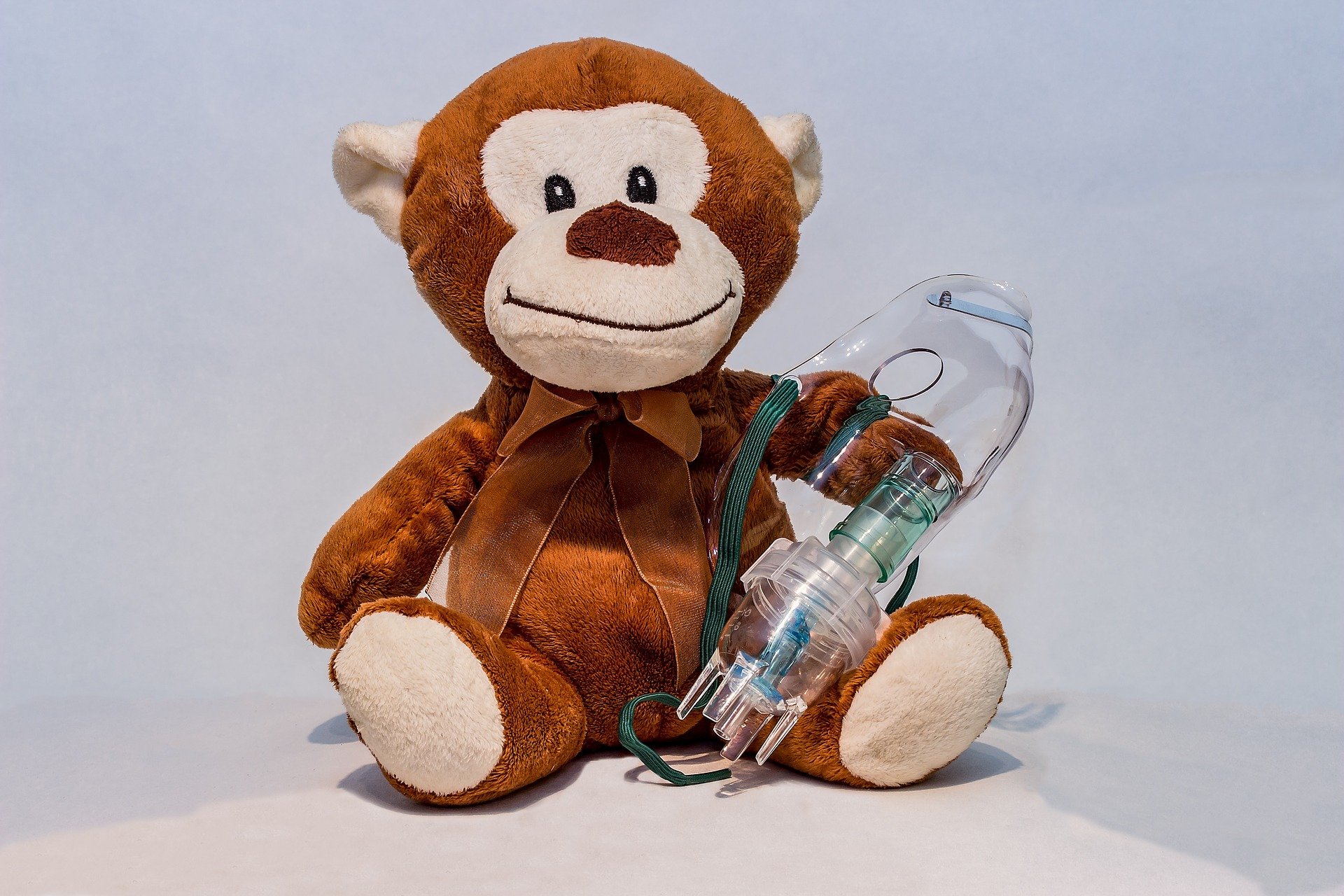
If you have COPD, there are many different things you need research and consider before planning an extended trip away. Overlooking even a small detail could be dangerous or throw a major wrench in your travel plans.
For instance, you need to thoroughly research your destination and where you're staying to ensure that you don't put your lungs in hazardous conditions. You also have to pack much more carefully so you don't forget any medication or medical equipment you need.
And if you have a prescription for supplemental oxygen, it gets even more complex. Knowing general oxygen safety isn't enough; you need to plan and prepare in order to avoid problems, accidents, and running out of oxygen.
If you suffer from COPD, failing to plan properly is not just irresponsible, but can actually be dangerous for your health. Poor preparation could result in missing your transportation or suffering from severe breathing problems far away from home.
In this article, we're going to show you how to make traveling with COPD and oxygen as safe and convenient as possible, whether you travel by plane, car, or any other mode of transportation. We'll tell you what to look out for, how to prepare, and how to handle your oxygen equipment safely on the journey.
Going far away from home can be scary when you have a chronic disease, especially if you have severe COPD. But if you follow the tips in this article, you'll be prepared for the challenge and able to embark on your journey worry-free.
The Challenges of Traveling with Oxygen
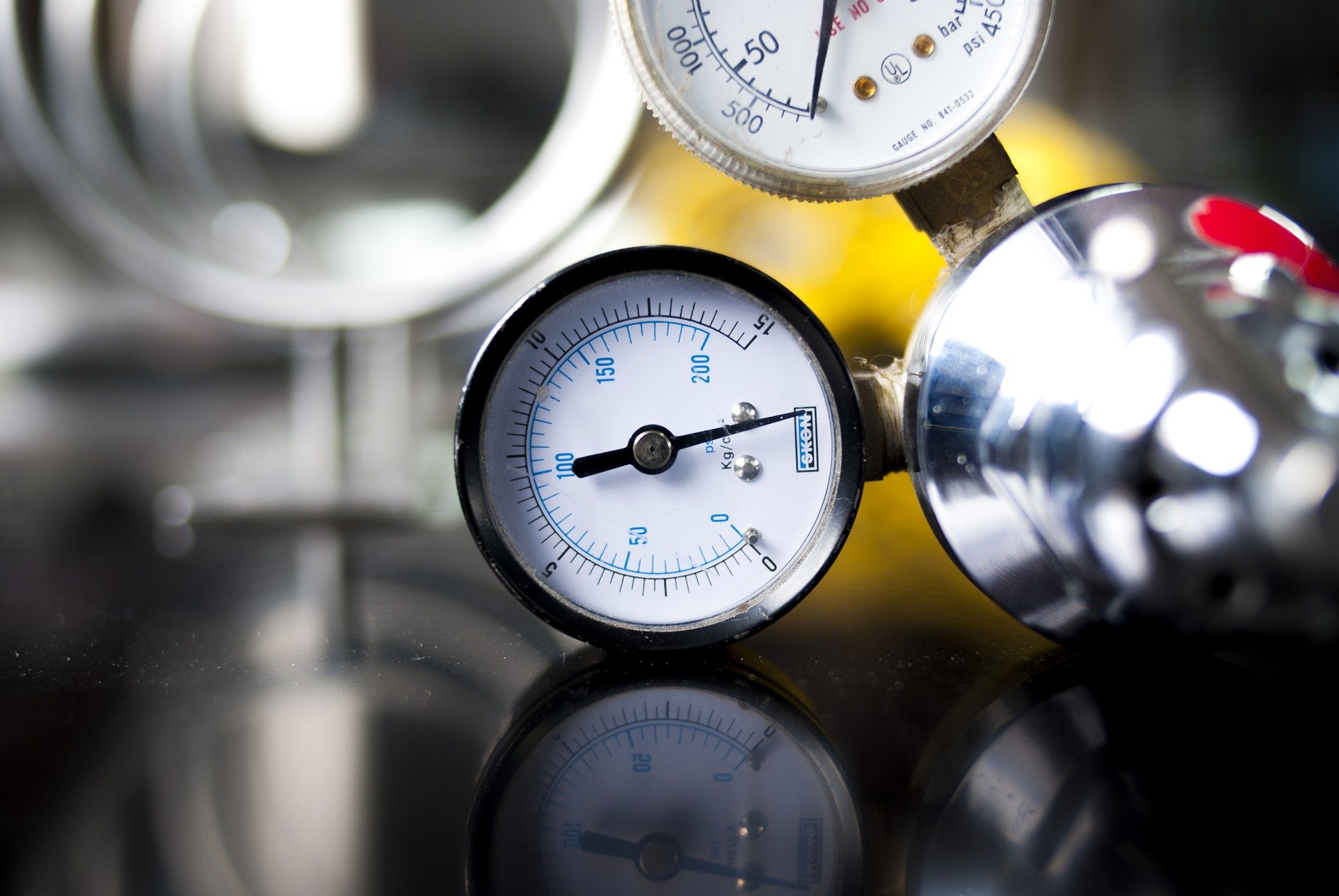
Millions of people in the US rely on supplemental oxygen, and it's a lifeline for many patients with COPD. If you or someone you love uses supplemental oxygen, then you need to learn all about how to safely use and transport oxygen when you travel.
Whether you use oxygen occasionally or continuously, lugging around heavy oxygen tanks and other equipment can be complicated and inconvenient. Being tethered to a medical device is not easy, and it's no wonder many patients feel limited or trapped by their oxygen therapy.
What makes traveling potentially dangerous for oxygen patients is that it takes you out of your familiar environment and far away from your doctor, home, and most possessions. If you forget any equipment, run out of oxygen, or something else goes wrong, it can be more difficult to get help in an unfamiliar place.
Another challenge of traveling with oxygen is that it disrupts your normal routine, which can make it difficult to keep up with your usual COPD treatment schedule. Traveling to new places can also expose you to new allergens and respiratory irritants, making flare-ups more likely and potentially increasing your oxygen needs.
There's also the problem of the mode of travel itself, which can limit your oxygen options and make therapy more complicated. For example, when you travel long distances by car, it can be difficult to access, adjust, and switch out your oxygen supply.
Traveling by plane is even more complicated because of airport security and restrictions on what you can bring aboard. Airlines usually only allow you to bring portable oxygen concentrators on the plane, as they consider liquid or compressed gas oxygen tanks a safety risk.
In general, traveling makes oxygen therapy more inconvenient at the same time that it becomes more difficult keep your symptoms at bay. It also means preparing for a variety of potential problems and situations that you can't control.
But even though living with COPD may make travel more complicated, you can still find ways to explore and have new adventures. In the next sections, we'll cover all of these complications and show you a variety of practical tips for traveling safely with oxygen and COPD.
{{cta('b59df0c1-c4de-47a8-8e1c-0d33d4b414aa','justifycenter')}}
First Steps Before Your Trip
Talk To Your Doctor!
Consulting your doctor should be the very first step you take before planning an extended trip away from home. It's important to get your doctor's okay, as well as important medical records and prescription information, before you travel.
First, talk to your doctor about where you are visiting and what kinds of events and activities you are planning to participate in. That way, if there are any concerns or red flags, your doctor can warn you and give you advice to help you avoid problems.
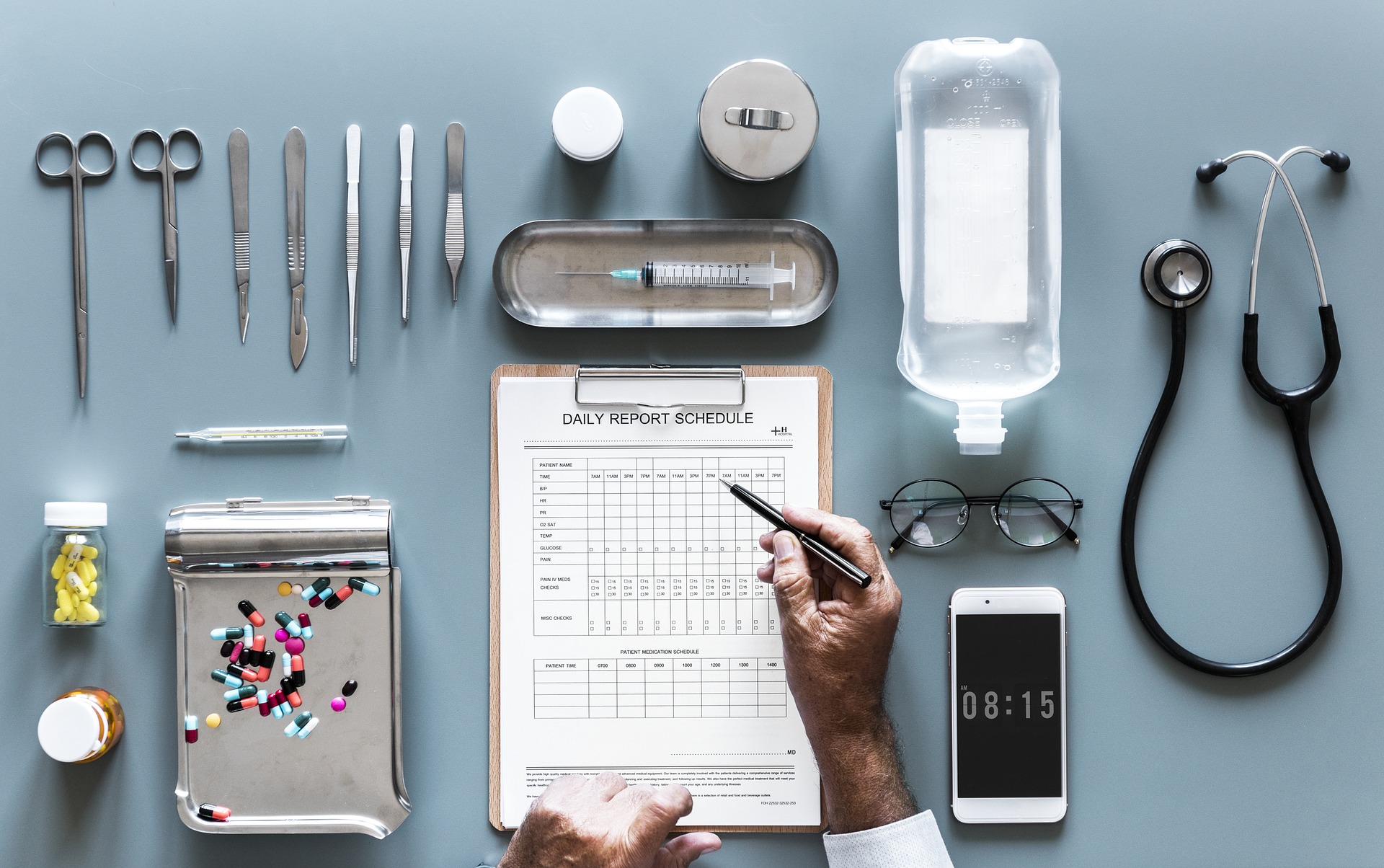
Depending on the severity of your COPD and any recent medical problems, your doctor might impose limitations on your travel or what sorts of activities you can do. He may also be able to give you helpful advice for managing your symptoms and continuing treatment on your trip.
You should also ask your doctor for a detailed list of your medications in case you need to verify your medicine with travel personnel at any point along your trip. You should also make sure you have your doctor's up-to-date contact information in case you have an emergency or simply need to ask a question.
Research Your Destination

Before you get your heart set on a destination, make sure you take some time to research the place you want to visit. That way, you can find out about any conditions that could affect your COPD and make arrangements ahead of time to minimize your risk.
Local climate conditions including weather, air pollution, humidity, and altitude are all important things to look up before you travel to an unfamiliar location. You should also look up local hospitals and medical services near your travel destination so you can get help quickly if something goes wrong.
For example, you will need to take extra precautions if you are planning to travel to a high elevation, such as taking extra medication or adjusting your oxygen prescription. Since there is less oxygen at high altitudes, you will have more difficulty breathing, and portable oxygen concentrators may not function correctly.
In especially hot, humid, cold, or polluted environments, you should be ready for flare-ups and prepare to treat more aggressive COPD symptoms. You may need to pack extra medication or equipment (such as a particle mask) to help you cope with poor weather and air quality.

In some cases, the conditions might simply be too dangerous for your health, especially if your COPD is severe or you've experienced a recent hospitalization. If your ideal destination will make it too difficult to control your symptoms and get the medical care you need, you should look for a different place to visit.
Even though travel and vacations are important, they're not worth putting your lungs or your life at risk. Most of the time, you can find a great alternative destination that is more accommodating and easier on your body.
As we mentioned before, you should always consult your doctor before going on any kind of extended trip if you suffer from COPD. If you or your doctor have concerns about climate conditions or medical services during your travels, it's important to take them seriously, even if it means making compromises.
Here are some tips for finding a safe, comfortable travel destination:
- If you are traveling far, do some research on the local climate so you know what to expect.
- Look out for rural places that are far from a hospital or sophisticated medical services. It's important to be able to get quick and effective medical attention in the case of a serious exacerbation or emergency.
- If you are sensitive to weather conditions, try to avoid visiting places with extreme temperatures or humidity. If you can, visit more extreme climates during a season when the weather is more mild and tolerable.
- Exercise caution if you are traveling to a higher elevation than what you're used to, as the air will be thinner and more difficult to breathe. If you have severe breathing troubles, you may need to avoid visiting high altitudes altogether.
- Write down the addresses and phone numbers of local hospitals and clinics in all the areas you are traveling to. Your doctor may even be able to give you recommendations for trusted medical professionals in the region.
{{cta('fa8abc2a-1e88-4fa3-82fd-1cb5b9ed43b2','justifycenter')}}
Choose Safe and Comfortable Lodging

Once you've chosen a suitable destination for your trip, you still need to find a comfortable place to stay. Unfortunately, not all hotels, resorts, and other types of lodging can accommodate people with special medical requirements.
If your COPD is severe or you use supplemental oxygen therapy, it's important to find lodging that accommodates your needs. You can often find information on medical conditions and disabilities on the company's website, but you should always call ahead to notify them and verify their amenities before your visit.
You should also make sure that the place you plan to stay at is clean, reputable, and has helpful, friendly staff. Here are some more tips for finding a safe and comfortable place to stay as you plan your next trip:
- If you are staying at an inn or resort, make sure they have smoke-free accommodations.
- Look up reviews from other guests who have stayed at the same place to make sure it is clean, safe, and friendly. Cross-reference reviews with the hotel's claims to ensure that what they promise doesn't differ significantly from the experiences of past guests.
- If your lungs are sensitive to fragrances and cleaning products, notify your hotel ahead of time. They may be able to use milder cleaning products or offer unscented toiletries in your room.
- Make sure that any events or venues you plan to visit are smoke-free environments.
- If you need any special help or disability accommodations, check with your hotel ahead of time to make sure they can provide adequate assistance.
- If you use oxygen, check with your hotel ahead of time to ensure there are no safety issues and that they are aware of your medical condition and needs.
- Make sure where you stay has a safe, secure place for you to store your oxygen or other medical equipment. You will need a well-ventilated place to secure any extra oxygen tanks you bring and a steady supply of electricity for your oxygen concentrator, if you have one.
- If you rely on an oxygen concentrator as your primary oxygen source, make sure you notify the hotel that you are bringing medical equipment that requires a constant electricity source. Make sure they have a backup generator or other safeguards in place in case of a power outage.
- If you have requested any special accommodations, make sure you check in with your hotel a few days before your visit to make sure everything is in order.
Stock Up on Oxygen and Other Medications

When you're far away from home, the last thing you want to do is run out of medication. It can be much more difficult to coordinate a prescription refill in an unfamiliar town, and disruptions in your daily medication schedule can be dangerous.
Not having your oxygen, inhaler, or rescue medication when you need it can cause dangerous breathing issues and even require you to go to the hospital. At the very least, going without your medication can cause your symptoms to flare up, which is never pleasant and could lead to a more serious exacerbation.
That's why you should talk to your doctor about stocking up on extra medications to bring with you if you are planning an extended trip. You may need more than your typical amount to last the duration, and you should ask for extra in the case of emergencies or in case you are away longer than expected.
If you use supplemental oxygen, it's particularly important to talk to your doctor and your oxygen supplier before the trip. They can help you make sure that you have enough extra oxygen to last in case of an emergency or one of your other oxygen sources malfunctions.
Depending on where you are traveling to and what company supplies your oxygen, you may even be able to get oxygen delivered to your travel destination while you're there. Each company is different, so you will need to work with your provider ahead of time to find a solution that works for your trip.
Once you've ensured that you will be in no danger of running out of oxygen, you should stock up on other oxygen delivery equipment you may need. You might want to bring extra sets of nasal cannulae, humidifier bottles, and any padding you use to make oxygen therapy more comfortable.
Gather Medical Paperwork

It's important to bring all of your medication with you on your trip, which means you should have a copy of your doctor's records for all of your prescriptions. You should also bring a copy of your COPD treatment and action plans to reference if you need to.
You should keep this paperwork with you at all times when you travel for both medical and security reasons. If you are traveling by plane, train, boat, or using any other transportation service, you may need to present your medical and prescription records to bring medication or oxygen on board.
It's also a good idea to have all of this information on hand in the case of an emergency or hospitalization. Doctors and emergency personnel will be better able to help you if they have immediate, detailed information on your medical condition.
Oxygen Travel Checklist

Careful planning ahead of trips is essential if you use oxygen therapy, especially if you need to use it continuously. It's important to take this preparation step seriously, or you could end up with a serious medical emergency.
To help you the next time you travel, here is a checklist of vital steps you should take before taking any kind of trip with oxygen:
- Notify the place you will be staying at that you are bringing oxygen. Ask if there are any special requirements or safety concerns.
- Get a note from your doctor with your brief medical history and a detailed list of all the medications you use, including your oxygen prescription. Keep it with you at all times when you travel.
- Make sure you have enough oxygen to last your whole trip. Contact your oxygen supply company if you need to stock extra.
- Make sure that your mode of transportation allows you to bring oxygen on board. Be aware that some transportation companies only allow portable oxygen concentrators or have restrictions on the number, type, size, or weight of oxygen canisters you can bring.
- If you are bringing a portable oxygen concentrator, make sure that you have enough batteries to make it last your whole trip. Depending on your mode of transportation, you may be able to plug your concentrator in to your car or recharge your batteries via an A/C outlet along the way.
- Make sure you have a safe, secure place to store extra oxygen tanks during your journey. If needed, your oxygen supply company might be able to deliver oxygen canisters to your destination for you.
- Flying with oxygen can be complicated, and what you need to do depends on which airline you are flying with. Refer to the section on traveling by plane (below) for more information.
Traveling by Car with COPD

Compared to other forms of transportation, traveling by car gives you more control over your trip and your immediate environment. This can make managing your COPD while you travel much easier, since you have more control over your schedule, your space, and any equipment and medications you bring.
Car travel also makes it much easier to bring oxygen and manage your oxygen therapy. As long as you can fit your equipment and canisters safely in your car, you don't have to worry about any restrictions or limitations on the kind of oxygen you can bring along.
Taking a road trip in your car is one of the most convenient ways to travel when you have COPD, but it still comes with some challenges. Before you plan your next road trip, you should learn how to protect your lungs on the road and transport your oxygen safely.
Avoid Respiratory Irritants

Pollution and respiratory irritants are the most hazardous aspects of car travel for people with COPD. When you spend extended amounts of time on the road, you need to be especially careful to protect yourself from car fumes and other respiratory irritants.
First, never smoke in the car or allow anyone else with you to smoke in the car or around you during the trip. This is particularly vital if you are transporting oxygen in your car, as sparking a cigarette becomes a major fire hazard.
If possible, make sure you are riding in a non-smoker's vehicle; even if no one is actively smoking, simply being inside a smoker's car can irritate your lungs and cause your symptoms to flare up. If there is no non-smoker's vehicle available, consider getting the car thoroughly cleaned by a professional or renting a different car for your trip.
Second, keep the windows rolled up as much as possible to keep air pollution, allergens, and exhaust fumes from wafting into your car. You can also set your car's ventilation system to continuously re-cycle the air in the car's cabin, which prevents it from pulling in polluted air from the road.
Over-Prep Your Vehicle and Route

When you have a chronic disease, mishaps like getting lost or stranded can be especially dangerous. If your car breaks down, you could end up stuck in hazardous conditions or even run out of oxygen.
That's why you should always get your car inspected and serviced before a long trip to check for any problems or malfunctions. Make sure they check all the basics, like ensuring your car has fresh oil and that your air filter, engine fluids, and brake pads don't need to be replaced.
You should also keep an emergency preparedness kit in your car along with a first aid kit, a spare tire and jack, and a small gas canister in case you run out of fuel. Your emergency kit should include, at a minimum: a tire guage, an emergency flare, reflective markers, jumper cables, extra water supply, blankets, and a flashlight.
To reduce the chances of any mishaps, you should plan your travel route thoroughly and carefully, making note of any road closures or other potential problems along your path. Make sure you have a map, smartphone, or a GPS device available in case you need to make last minute changes to your route along the way.
As you plan your route, try to avoid busy highways, high-traffic roads, and areas with high levels of allergens you are sensitive to. This will reduce the amount of respiratory irritants your lungs are exposed to and make your symptoms less likely to flare up.
Take Breaks
Even though you spend most of the time sitting down, extended road trips can be physically exhausting. Being stuck in such a small, cramped place can get extremely uncomfortable after awhile.
Building stops and breaks in to your trip, however, can significantly reduce the stress and physical strain of long trips in the car. Make sure you give yourself plenty of opportunities to pause, stretch your legs, and take bathroom trips along the way.
If you need to, break your trip up into smaller chunks find places along your route you can stay at overnight. This can help the trip feel more bearable and can also make it easier to keep up with your normal COPD treatment routine.
Sitting for very long periods of time is not healthy for your body, so you should take every opportunity to stretch and move around when you travel. Stand up, take a short walk, and get your blood flowing at regular intervals during your trip.
Taking Oxygen on Your Road Trip

Transporting oxygen in your own car is much simpler than taking it on any other mode of transportation. The only major things you have to worry about is bringing enough oxygen and making sure you have a safe place to store it in your car.
Oxygen canisters, whether liquid or gas, should always be stored upright in a well-ventilated place. That means you should never transport oxygen canisters in your trunk, which is too small and enclosed a space to store them safely.
Instead, it's best to store extra oxygen canisters on the floor of your car in the space behind the driver's or passenger's seat. If you are using oxygen while traveling, you can store your current oxygen supply in the seat next to you. If you are a passenger, you can also store your canister or portable oxygen concentrator on the floor in front of you, if there's space.
If you are traveling in a warm climate, make sure you never leave your oxygen cylinders for too long in the hot car. If you will be leaving the car in the heat for an extended period of time, you will need to remove the cylinders from your vehicle and find a secure, climate-controlled place to store your oxygen while you're gone.
Lastly, it's important to make sure that you bring enough oxygen with you to last you your whole trip. If you don't have enough space to store it all in your car, talk to your oxygen supply company to see if they can deliver more to you at your destination.
Flying by Plane with COPD

Planes are one of the more difficult modes of transportation to use if you have COPD. It's significantly more difficult if you are traveling with oxygen, because of airport restrictions and security. In fact, if you don't have a portable oxygen concentrator, you cannot bring oxygen on a plane at all.
There are several important things to remember b
Living with a respiratory disease can make normal activities and hobbies difficult. Traveling, however, can be particularly challenging to do when you suffer from a chronic respiratory condition.
Traveling brings up concerns about medication, supplemental oxygen, access to proper medical care, and more. But if you're traveling to a higher elevation than you are accustomed to, then you have to consider the effects of high altitude as well.
{{cta('fa8abc2a-1e88-4fa3-82fd-1cb5b9ed43b2','justifycenter')}}
The thin air at high elevations can cause a variety of respiratory symptoms in healthy people and is particularly troublesome for people who suffer from COPD or another respiratory illness. Short periods of exposure to the thin air found at high altitudes can cause shortness of breath and a condition known as altitude sickness. Long-term exposure can lead to even more serious and potentially life-threatening complications.
If you live at high altitude or plan to travel to high elevations, it's important to understand how the thin air can affect your condition over time. If you're not accustomed to high altitudes, you need to know what to expect so you can take the proper precautions before traveling to areas where it may be a concern.
In this post we're going to help you do just that by telling you everything you need to know about respiratory diseases and high altitudes. We'll explain how high altitudes affect your respiratory illness, how to prevent negative symptoms, and what kinds of tools and medications can reduce your chances of adverse effects.
How High Altitudes Affect Your Body

High-altitude regions like the mountains host some of the most beautiful landscapes and alluring vacation spots. But the effects of high altitude in these areas can be troublesome, especially if you are living with a chronic respiratory disease.
The air at higher elevations is much thinner than the air at sea level and contains significantly less oxygen. Because of this, your lungs have to work extra hard to absorb enough oxygen to meet your body's needs.
Your lungs compensate for the lack of oxygen at high altitudes by increasing your breathing rate, and your cardiovascular system compensates by increasing your blood pressure and heart rate. This can cause you to feel extra breathless and fatigued.
These changes are often harmless, but for some people high altitudes cause a lot of discomfort. Some people are more sensitive to changes in elevation than others and are more prone to experience a variety of symptoms associated with altitude sickness.
Altitude Sickness

Altitude sickness occurs when your body can't get enough oxygen because of the thin, oxygen-poor air at high elevations. When this happens, your blood oxygen saturation drops and your body kicks into high gear to respond.
Some of the symptoms of altitude sickness are caused by your body's attempt to make up for the lack of oxygen, while other symptoms are a result of hypoxia. Anyone can succumb to altitude sickness, but those with respiratory diseases are especially at risk.
Here are some of the common symptoms of altitude sickness to watch out for:
- Headache
- Light headedness
- Nausea and vomiting
- Shortness of breath
- Decreased appetite
- Difficulty sleeping
- Rapid heart rate
- Rapid breathing
- Reduced endurance and fatigue
There is another type of altitude sickness called high-altitude pulmonary edema, which occurs when fluid builds up in your lungs as a result of traveling to high elevations. This is a very rare condition, but it can be life-threatening if not treated quickly.
Symptoms of pulmonary edema include worsened shortness of breath, a wet cough, frothy sputum, and heart palpitations. If you experience these symptoms after traveling to a high altitude, seek emergency medical attention immediately.
How High Altitudes Affect People with Respiratory Diseases

Scientists who research the effects of elevation on COPD have found that high altitudes tend to make COPD symptoms worse.
High altitudes require you to breathe faster, breathe deeper, and use more energy to breathe. If the air is very oxygen poor, it can be impossible to get enough oxygen and cause your blood oxygen levels to drop, leading to hypoxia.
Thus it should come as no surprise that people with respiratory diseases have to be extra cautious in the thin air at high elevations. After all, traveling to high altitudes causes breathlessness and other respiratory symptoms often in healthy adults, so it stands to reason that people with reduced lung function would struggle even more.
The extra strain that the thin air puts on your lungs makes it harder to breathe and can make symptoms that you already have worse. High altitudes also affect your endurance; you might notice that you feel fatigued and short of breath easily when doing any kind of physical activity at high elevations.
High altitudes are not all bad for your lungs, however. In fact, if you suffer from asthma or allergies, spending time at a high altitude might actually improve some of your symptoms.
That's because there's less less pollen and other allergens in the air at high altitudes. So, while spending time in high altitudes might make your COPD symptoms worse, it might also soothe other symptoms of asthma and allergies if you suffer from them as well.
Factors to Consider Before Traveling to High Altitudes

High altitudes affect every individual differently, but there certain factors that put you more or less at risk of suffering ill effects. If you're planning to travel to a higher elevation, make sure you take the following factors into consideration before you go:
The Severity of Your Disease
If your respiratory disease is mild, you might only notice minimal negative effects at high elevations. But if your disease is severe, you should be prepared for the possibility that you will experience greatly worsened symptoms or exacerbations because of the thin air.
That's why it's important to consult with your doctor before you travel, especially if you are heading to a climate or an elevation that's significantly different from what you are used to. Your doctor will be able to warn you about any potential problems and help you get any medications or treatments you might need before you go.
The Difference in Elevation
How much the altitude affects you depends on what elevation your body is already accustomed to. If you already live at a higher altitude, then traveling to the mountains will be easier than it would be for someone who lives at sea level.
The relative difference in altitude between where you live and where you are traveling matters, and you can calculate it by subtracting your home city's elevation from the elevation of your travel destination. To do this yourself, you can visit elevationmap.net to find the elevation of cities all across the world using their handy search tool.
Living at High Altitudes

If you live at a high elevation, then you have probably already adjusted to the acute effects of the high altitude. Our bodies adapt to handle the thin air fairly quickly, and it usually only takes a couple weeks at most to shake off the negative symptoms.
There are two main changes that happen in your body over time that helps it acclimate to oxygen-poor high altitudes. First, your lungs adapt by enlarging to increase their oxygen absorption abilities, making it easier to breathe. Second, your circulatory system adapts by making extra blood vessels and red blood cells in order to more efficiently transport oxygen to all the different parts of your body.
However, even after your body adapts, the thin air can still negatively affect your respiratory disease in the long term. It makes it more difficult to manage respiratory symptoms like breathlessness and wheezing and can lead to more serious complications over time.
The oxygen-poor air at high elevations force your lungs to work much harder to get enough oxygen than they would have to at sea level. The higher the altitude, the more the effect worsens, which is why most doctors recommend that people with chronic respiratory diseases live at lower altitudes if possible.
If you do choose to live at a high altitude, it's important to get your blood oxygen levels tested regularly and have an effective treatment plan to prevent your blood oxygen saturation from falling too low. If you aren't extra careful to make sure you are getting enough oxygen every day, you could suffer from hypoxia which leads to pulmonary hypertension, heart failure, and death.
Make sure to talk to your doctor if your respiratory symptoms are severe or you are concerned about the long-term effects that living at a high altitude could have on your lungs. Your doctor can help you better understand the risks and help you determine whether or not moving to a lower altitude would be good for your health.
Tips for Managing High Altitudes
It's important to be knowledgeable and prepared before traveling to high altitudes, especially if you have reduced lung function because of a respiratory illness. That means knowing the risks of high elevations and understanding how to minimize those risks as well.
In this next section we'll discuss what you can do to minimize your chances of complications and discomfort when spending time at high altitudes. We'll tell you what you should bring, what you should watch out for, and how you can help your body and lungs adjust to the thinner air.
Take it Slow
Whenever you travel to a high altitude that you're not used to, it's important to give your body time to adjust. Even healthy adults have to take it easy while their bodies acclimate to the thinner air, so you should be doubly cautious if you suffer from a chronic respiratory illness.
First, don't plan anything more than light activity for the first few days you spend at a high elevation. You can expect to have much less physical endurance than you typically have, so don't plan long hikes, aerobic exercise, or any kind of strenuous activity until after you've had time to adjust.
It takes most people at least several days to adjust completely to the high altitude, but it can take up to a week or two for some. The higher the elevation that you're traveling to is compared to the altitude you're accustomed to, the longer it will probably take you to adjust. Make sure you plan accordingly.
Drink Plenty of Water

High altitudes cause you to lose water and get dehydrated more easily. Dehydration is a main contributor to symptoms of altitude sickness, and drinking plenty of water is one of the best ways to prevent it.
That means you'll have to remember to drink extra water when you travel to higher elevations if you don't want to feel breathless and fatigued. If you go on any hikes or excursions, make sure to bring an extra water bottle or two along with you.
Avoid or Limit Alcohol
For many people it's only natural to celebrate with alcohol while traveling or enjoying a well-earned vacation. However, if you're traveling to a high elevation, you should be very cautious about how much you drink.
Alcohol's effects tend to be stronger at high altitudes and can make altitude sickness even worse. You might also find that it takes less alcohol to feel tipsy or that you experience worse dehydration or hangovers when you drink.
It's best to avoid drinking any alcohol until after your body has adjusted to the high elevation. If you do choose to drink, take it slow, and remember that it will take less alcohol than usual for you to feel its effects.
Regardless of elevation, alcohol can still cause your throat to relax at night when you sleep, making it more difficult to breathe. To keep this from happening, take care not to drink alcohol late in the evening or in the three to four hours before you go to sleep.
Tools For Managing High Altitudes
If you suffer from a chronic respiratory disease, you should expect to have extra breathing difficulties when you travel to higher altitudes. It's important to go prepared with all the tools and medications you might need to manage your symptoms in the oxygen-poor air.
Supplemental Oxygen

Low oxygen levels at high elevations make it difficult for people with reduced lung function to breathe in enough oxygen to meet their bodies' needs. You might find that you need to use extra supplemental oxygen when you travel to higher altitudes, even if you haven't needed it before.
If you currently require supplemental oxygen therapy, you'll need to be extra cautious when you travel to a higher altitude. Make sure you have a large enough supply of portable oxygen to last you the whole trip, accounting for the fact that you might need more than you usually do.
It's a good idea to have your doctor do an oxygen evaluation before you travel or move to a higher elevation, even if you don't use supplemental oxygen right now. You doctor can test your lung function to determine whether or not you are likely to need supplemental oxygen or adjust your current oxygen prescription if needed.
Pulse Oximeter

When you travel to higher altitudes, the lack of oxygen in the air can make you more prone to hypoxia, or low blood oxygen saturation. And if you're not used to managing your disease in the thin air, you might not be able to notice or prevent it from happening as easily as you could at home.
That's why you should consider bringing a personal pulse oximeter with you on your trip if you travel to a high elevation. Personal pulse oximeters are small, portable devices that you can use to read your blood oxygen levels in moments, simply by clipping the device to the end of your finger.
You might need to keep track of your pulse oximeter readings for awhile before you understand exactly how they change in relation to different activities and symptoms. You can also talk to your doctor to learn more about how to properly use your pulse oximeter, how to interpret its readings, and to calibrate your pulse oximeter if needed.
Pulse oximeters are very cheap and very useful for a variety of situations. When you travel to high altitudes, you can check it often to make sure you are getting enough oxygen and better understand how the altitude affects your COPD. A pulse oximeter is also a useful tool to use if you use supplemental oxygen therapy, because it lets you know when your blood oxygen drops too low.
All of Your Medication

It is especially important to keep all of your medications and treatment tools with you when you're at a high altitude. That way you'll be prepared if you start to feel chest tightness, shortness of breath, or any other respiratory symptoms.
Make sure to talk to your doctor about any extra medications you might need to help you feel comfortable at a higher elevation, especially if you know that you're sensitive to high altitudes. Even if you usually only need your inhaler occasionally or during heavy activity, you might find that you need to use your medications more often at high elevations, or during periods of lighter activity as well.
Conclusion
It's important to know what you're getting into before you travel to a high altitude if you have COPD. If you aren't prepared, you might find yourself too breathless to participate in any fun activities you have planned.
If you follow the tips on this list, you should be able to minimize the negative effects of high altitude and avoid getting stuck in bed with altitude sickness. If you bring all the tools and medications you need, you'll be prepared to manage any worsened COPD symptoms that you experience.
.png)
If you tuned into our blog earlier this month, you know that we discussed COPD as a “systemic disease.” In other words, it’s a disease that affects every part of the body, not just the lungs. This is an important distinction to make because it enables both patients and medical professionals to detect systemic manifestations earlier on and treat them more effectively. One of the systemic manifestations that we mentioned in this post is osteoporosis, a disease that affects the density of the bones.
{{cta('fa8abc2a-1e88-4fa3-82fd-1cb5b9ed43b2','justifycenter')}}
Osteoporosis is a common comorbidity of COPD, meaning the two conditions often exist side-by-side. Because of the nature of the two diseases, there are many complications that arise as a result of having them both. For example, both COPD and osteoporosis increase the patient’s risk of experiencing a fall as well as getting seriously injured from a fall. In this post, we’re going to take a closer look at the connection between COPD and osteoporosis, how they’re related, and how to cope with each. If you have any questions or concerns, be sure to leave them in the comment section below so that we can get back to you.
What is Osteoporosis?
Your bones are in a constant state of repair. Cells called osteoblasts synthesize bone material and assist in the mineralization of bone tissue. Simultaneously, cells called osteoclasts degrade old bone tissue and send calcium back into the blood. After a year, your body has regenerated about 10 percent of its bone tissue. The reason your body does this is that bone tissue does not last forever. It needs to be replaced regularly in order for your bones to be strong enough to support the weight of your body.
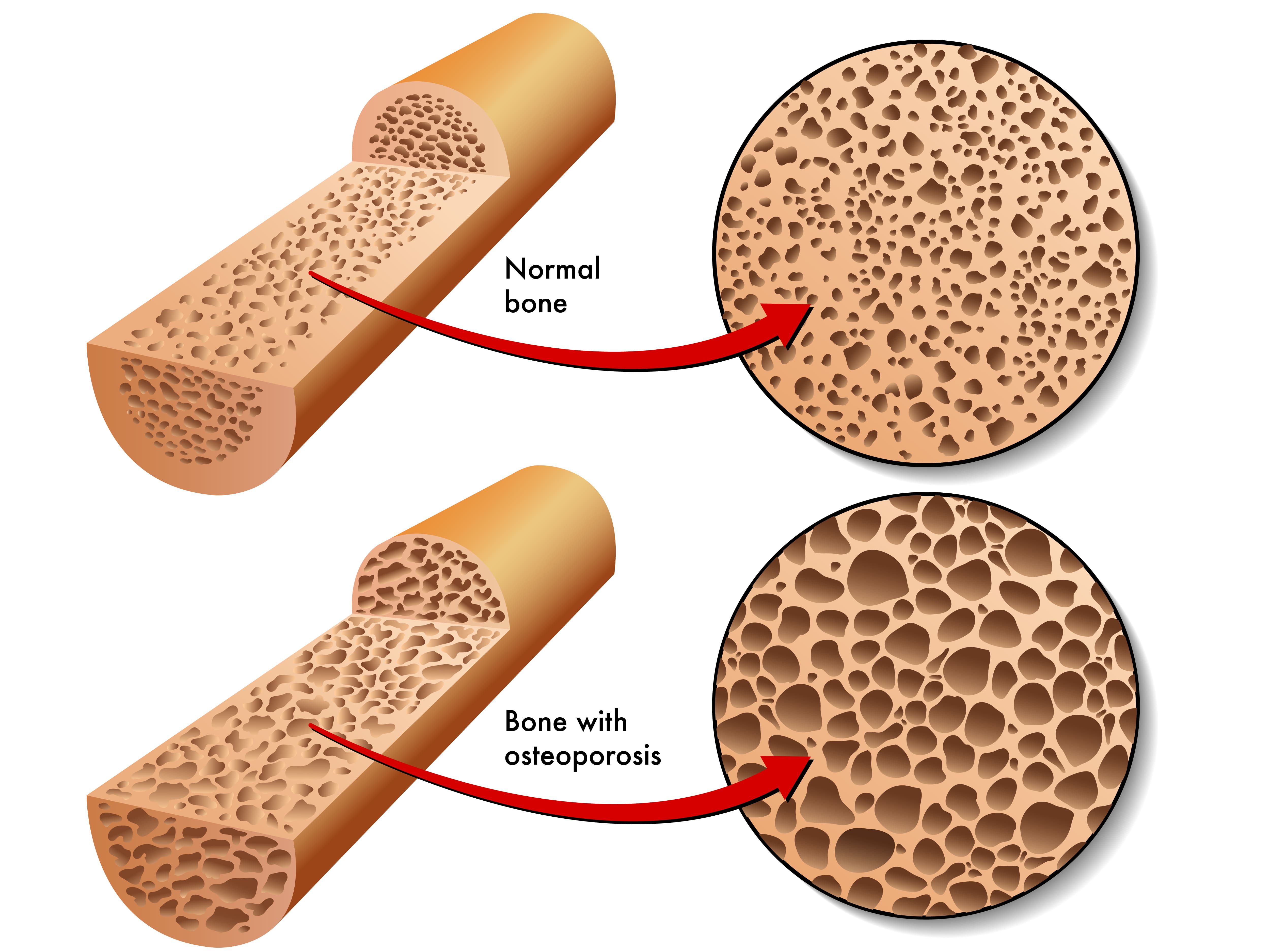
It’s natural for bone remodeling to occur more slowly the older we get. However, if the rate at which bone is produced is much slower than it’s being removed, or it’s being removed much quicker than it’s being replaced, this is known as osteoporosis, a disease that affects around 10 million Americans. Osteoporosis is more common in women over the age of 50, but anyone can get it at any age.
{{cta('b59df0c1-c4de-47a8-8e1c-0d33d4b414aa','justifycenter')}}
Osteoporosis usually develops very slowly and people are at a higher risk if they have a lower “peak bone mass.” Most people reach this point when they’re in their mid-twenties to thirties, so osteoporosis can sometimes (but not always) be predicted. Oftentimes, there are no warning signs of osteoporosis until the patient experiences a fracture. However, some people will experience joint pain, back pain, or a stooped posture. One instance where you may receive an early diagnosis of osteoporosis is if your doctor believes you are at high risk for this condition.
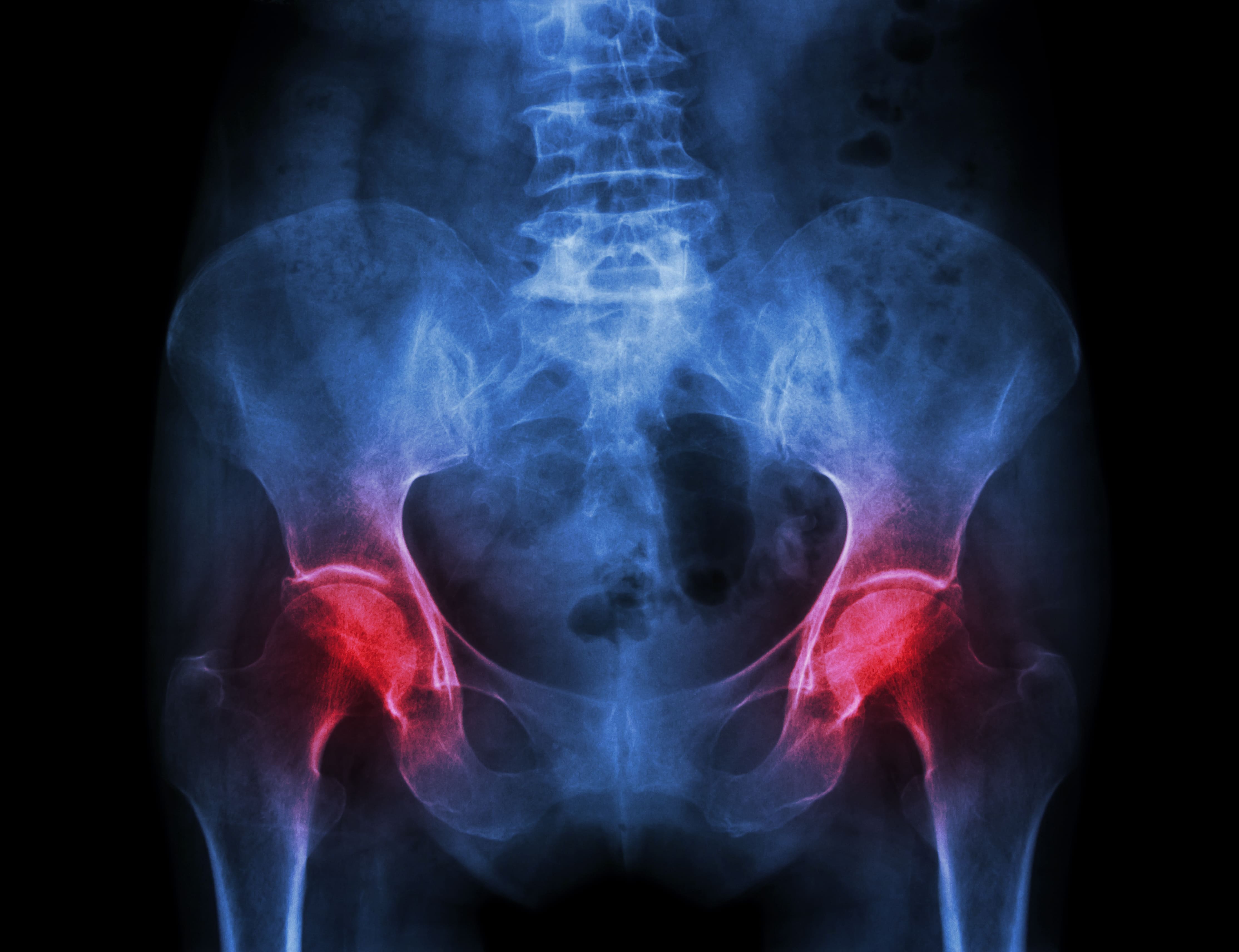
Bone fractures in the hip or spine are some of the most serious complications of osteoporosis because they impair the patient’s mobility. Falls are the most common cause of these types of injury but in severe cases, bones can fracture from simply bumping into something, bending over, or coughing. While there is no cure for osteoporosis there are many treatment options available that can help boost the rate of bone growth in your body, thus helping to prevent fractures and chronic pain.
How is Osteoporosis Diagnosed?
The main test used to diagnose osteoporosis is called a bone mineral density (BMD) test. It uses a type of low-energy X-ray called Dexa-Scan (dual-energy X-ray absorptiometry or DXA) to calculate the density of bone in the spine and hip. Your bone mineral density (BMD) is compared to the mean BMD for your age to determine if you have either osteoporosis or osteopenia. This is a condition that simply means you have low bone mineral density, it doesn’t necessarily mean that you will develop osteoporosis in the future or that you’re at risk of experiencing a fracture. If your BMD is less than one standard deviation below the mean, your bones are normal. Between -1 and -2.5 standard deviations is considered osteopenia and more than -2.5 is osteoporosis.

There are many other tests that can be performed to assist health professionals to determine if you have osteoporosis. Computerized tomography (CT) scans, X-rays, ultrasounds, and body composition analysis which shows the percentage of body weight due to bone, fat, muscle, and water. There are also many blood tests that can assist in diagnosing osteoporosis including blood calcium tests, vitamin D tests, thyroid tests, and testosterone tests. Be sure to ask your doctor if you’re not sure which test you need to take.
What’s the Link Between COPD and Osteoporosis?
At first glance, you might notice a lot of similarities between COPD and osteoporosis. Both conditions are more common in older adults, more common in women, and they can’t be cured. However, they’re both highly treatable. In other words, you’re at a higher risk of contracting COPD and osteoporosis based on your age and gender alone. But when you take a closer look, you’ll notice that there are many common side-effects of COPD that put you at a higher risk of osteoporosis in old age.

According to a study published by the National Health and Nutrition Examination Survey (NHANES) which included 14,828 subjects over the age of 45, there was an 8.5% prevalence of osteoporosis in non-COPD patients, but there was a prevalence of 16.9% in COPD patients. Let’s take a look at some of the side effects of COPD that may lead to osteoporosis.
A History of Smoking
Smoking is the most common preventable cause of morbidity and mortality worldwide. Smoking has countless systemic effects ranging from lung cancer to heart disease. Studies have also shown for decades that tobacco use has extremely adverse effects on bone health, not least of which is decreased bone density. According to UCI Health, there are several reasons why smoking is so bad for bone health. Firstly, it reduces the flow of blood to your bones by causing your blood vessels to constrict. This means your bones are being deprived of vital resources including osteoblasts, the bone-producing cells. Smoking has also been shown to hamper the resorption of calcium meaning it can’t be replaced in the bones.

There isn’t much to say about smoking and COPD that hasn’t already been said. According to the American Lung Association, about 85 to 90 percent of COPD cases are caused by cigarette smoking. What’s more, about 38 percent of people with COPD continue to smoke after receiving a diagnosis. It goes without saying that, if you’re a current smoker, the sooner you quit, the better. The respiratory effects of smoking are bad enough on their own, but when they’re combined with chronic pain and an increased risk of fractures, these issues are exacerbated.
Diet
Your body needs a large variety of vitamins and minerals in order to maintain every bodily function from digestion to blood flow. But when you develop a chronic condition, you often need to adjust your diet to accommodate for certain deficiencies that you may develop. In COPD and many other respiratory diseases, vitamin D deficiency is very common. Vitamin D is essential for everyone because it plays a vital role in helping your body absorb calcium which is the main support structure for your bones. Without it, your bones will become weak and brittle.

One of the main reasons respiratory patients are vitamin D deficient is that they oftentimes aren’t exposed to as much sunlight as their healthy counterparts. Sunlight is the most important natural source of vitamin D, but many COPD patients are immobilized by symptoms like fatigue, breathlessness, and chronic pain. One way to combat this is to simply sit by a window where you’re receiving direct sunlight. If you live in an area that doesn’t receive sunlight for prolonged parts of the year, you can supplement your diet with vitamin D-rich foods like oily fish, red meat, or egg yolks.
Body Mass Index (BMI)
Body mass index is derived from your body weight and height. Anything between a BMI of 18.5 and 24.9 is normal, but if you dip below this or go above it, it may be cause for concern. While the United States suffers from an obesity epidemic, COPD patients often suffer from the opposite problem — being underweight. According to the Lung Institute, COPD patients burn an average of 10 times as many calories while breathing as their healthy counterparts do. This is why many doctors recommend that COPD patients increase their caloric intake after being diagnosed. According to Healthline, about 25 to 40 percent of people with COPD have low body weight.
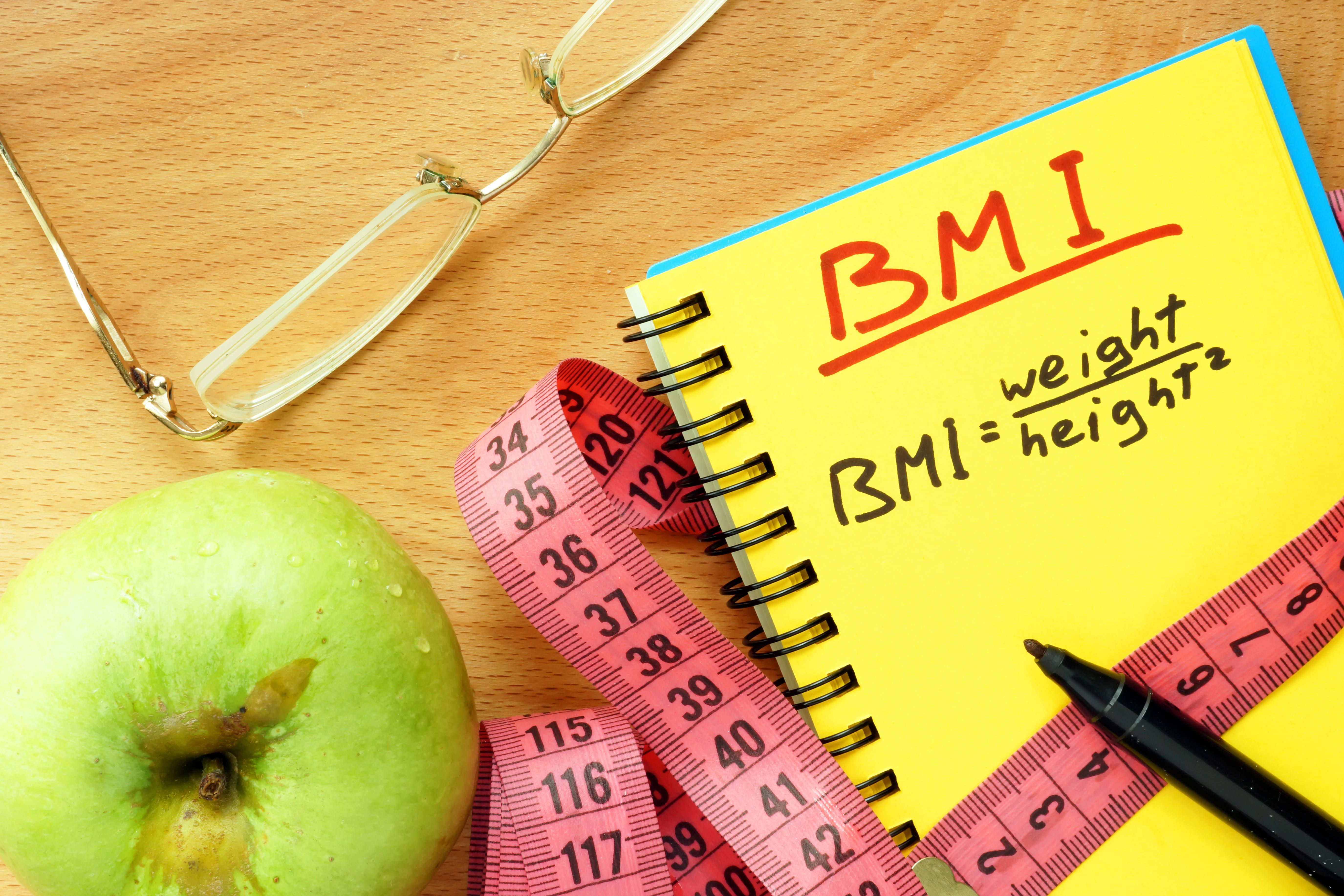
Having a BMI under 21 is also a risk factor for low bone mineral density (BMD) and osteoporosis. Studies have shown that BMI inversely correlates with BMD, so the lower your body weight is in comparison to your height, the more at risk you are for developing weak bones. As a COPD patient, the best thing you can do to prevent this is to ensure that you are eating enough and that you are following your doctor’s advice on what to eat. If you experience exhaustion from consuming large meals, try eating smaller meals all throughout the day in order to meet the calorie requirement that your doctor has set. This also helps your body out with digestion and prevents feelings of fatigue and bloating after eating.
Physical Activity
Exercise is one of the key components of an effective COPD treatment regime. Exercise keeps the lungs strong and healthy, reducing symptoms of breathlessness and chest pain. Strong muscles also use oxygen more effectively meaning you’ll be able to stay out of the house and stay active longer without taking a break. And while exercise can’t reverse COPD, it can improve your life expectancy and quality of life. Be sure to discuss with your doctor which exercise program will be best for you. Most health specialists recommend pulmonary rehabilitation which involves lung education, strength training, and endurance training.
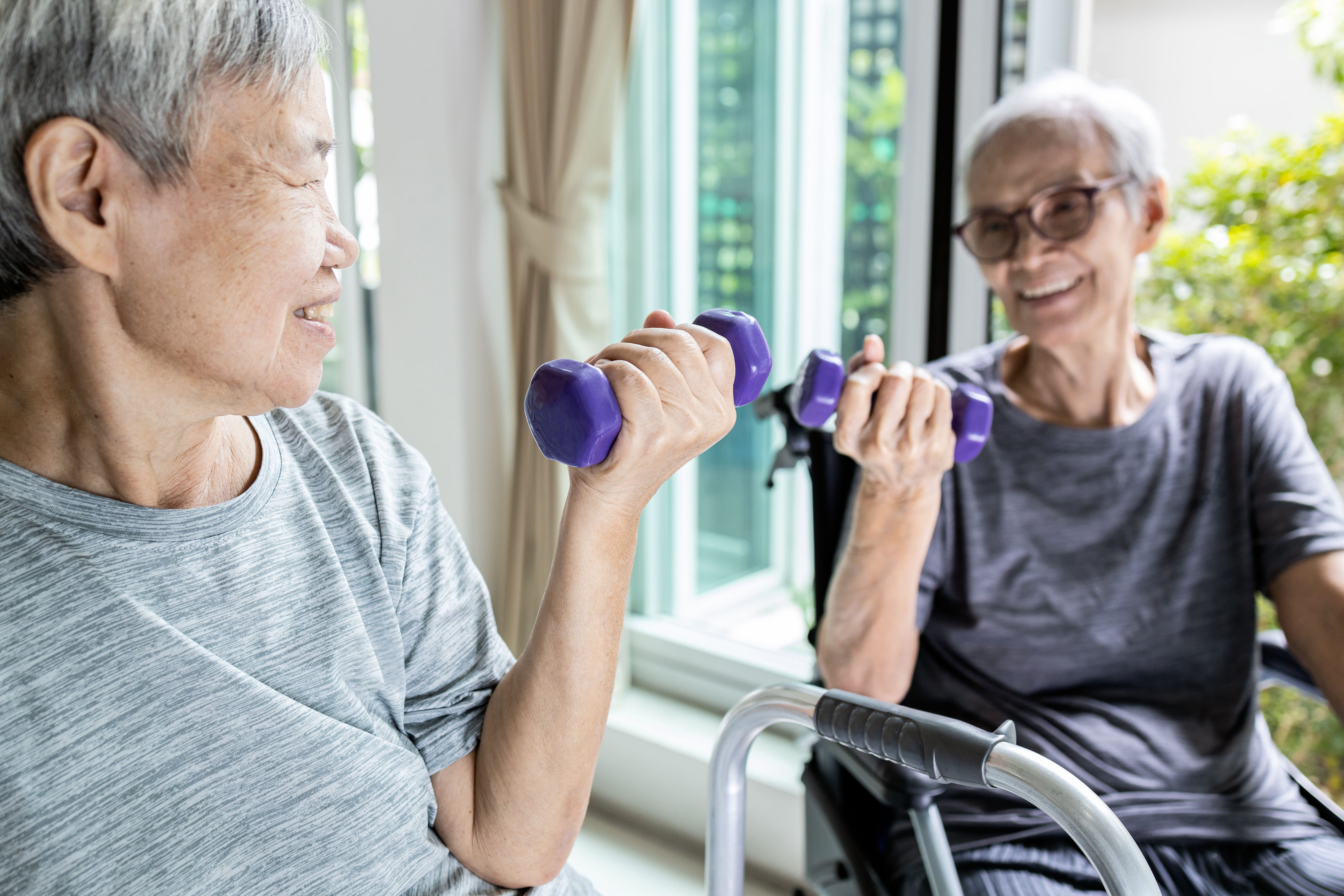
According to Orthoinfor.aaos.org, exercise affects bones similar to how it affects muscle — it makes it stronger. Bone is living tissue and when stress is applied to it, it reacts by building more tissue. So, it goes without saying that, by exercising regularly, you can keep your bones in good condition and prevent osteoporosis. Unfortunately, due to the respiratory symptoms of COPD, many people are left feeling unmotivated or unable to exercise, and in turn, their bone health begins to suffer. You should aim to exercise at least 3 to 4 times per week and since hip and spinal fractures are most common in osteoporosis, be sure to get on your feet and work your whole body, not just your arms. Exercise also strengthens your stabilizer muscles, helping to improve balance and prevent falls.
COPD Medication
One final way that COPD affects your bones is through your medication. Your medication is a vital part of your treatment plan, but you have to be careful with it because, like any medication, it has both short- and long-term side effects. Most of the side effects should be listed on the container of the medication, but for more specific information, be sure to consult your doctor. The main COPD medication of concern when it comes to bone health is corticosteroids. These drugs are used by COPD patients to reduce inflammation which can prevent flare-ups and exacerbations. Corticosteroids are usually inhaled via an inhaler or nebulizer in order to reach the lungs more quickly.
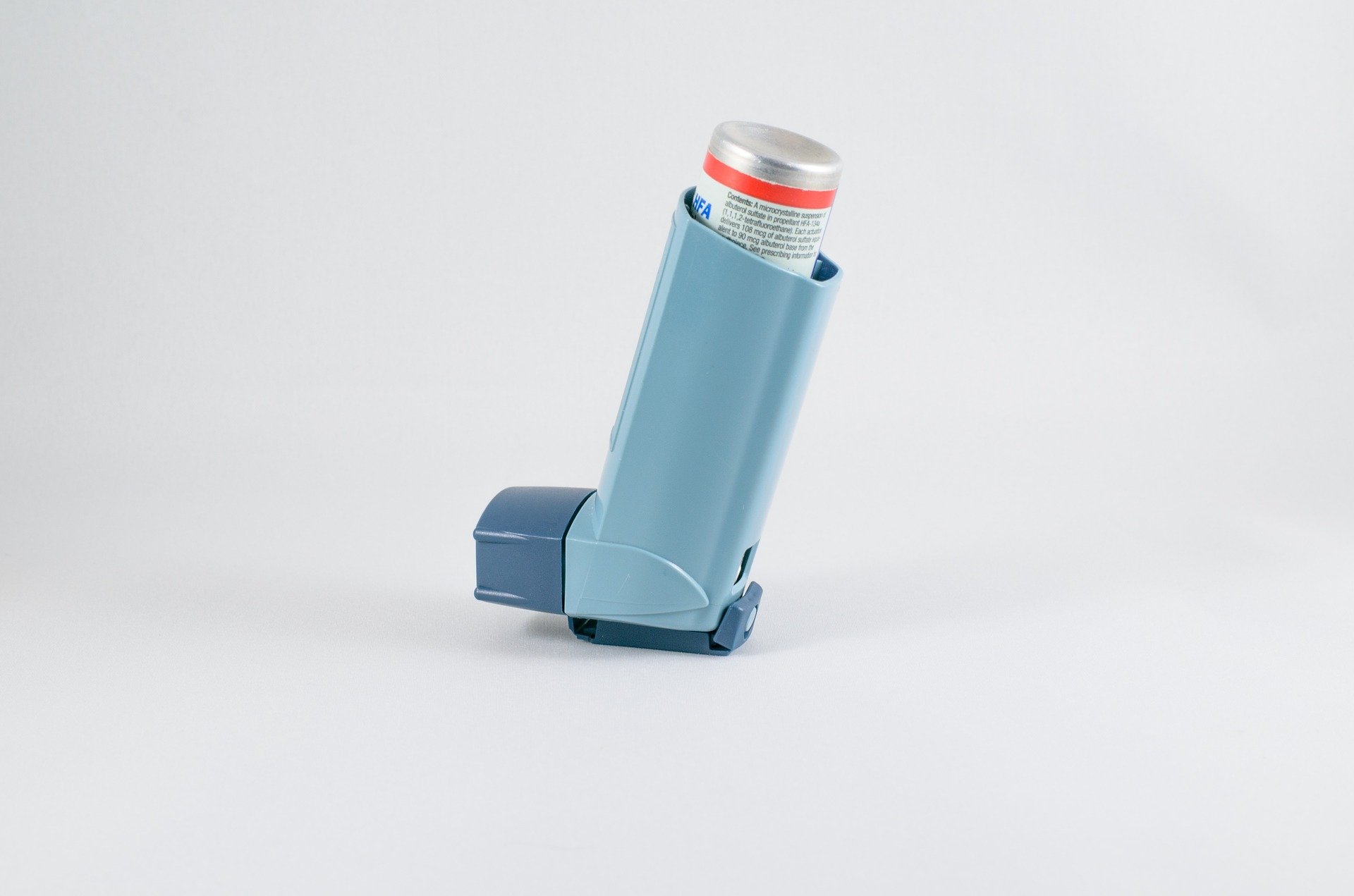
The way that corticosteroids affect the bones is by altering the way the body uses vitamin D and calcium. Oftentimes, corticosteroids increase the rate at which bone breaks down and reduces its ability to absorb calcium. If corticosteroids are used heavily, this could lead to rapid bone deterioration, so it’s important to use them only as they’re prescribed. If you’re still concerned about bone loss even while taking the normal dosage, be sure to ask your doctor if there are any alternative medications that you can take without this side effect.
Conclusion
COPD is one of the most common chronic illnesses in the world. However, many people are unaware of the many systemic manifestations of this disease. About 36 to 60 percent of COPD patients have osteoporosis which is higher than the general population. The good news is that just a few lifestyle changes can significantly reduce your risk of experiencing low bone mineral density and osteoporosis. Immediate smoking cessation, a revised diet, regular physical activity, and careful use of your COPD medication are just a few of the most important.
If you’re a COPD patient who’s struggling to get on your feet and maintain an exercise routine, consider upgrading your obsolete oxygen device to a portable oxygen concentrator. POCs are much smaller and lighter than a standard oxygen tank meaning you won’t feel out of breath after a short walk. Portable oxygen concentrators like the Inogen One G5 and Caire FreeStyle Comfort have taken the oxygen industry by storm with a simple, easy-to-use interface, sleek design, and high oxygen output. If you’d like to learn more about these devices and all that they have to offer, don’t hesitate to reach out to our oxygen concentrator specialists here at LPT Medical.

If you grew up hearing the phrase “an apple a day keeps the doctor away,” then you’ve probably spent your life trying to eat healthy foods. However, “eating healthy” isn’t necessarily just about eating healthy food; it’s about getting the right balance of nutrients that your body needs.
If you eat an apple every morning, that’s great! Apples are perfect for a quick energy boost, they help with weight loss, and they’re a heart healthy snack. But they also lack many of the vitamins and minerals that lead to optimal health.
{{cta('fa8abc2a-1e88-4fa3-82fd-1cb5b9ed43b2','justifycenter')}}
Another thing many people don’t consider is that nutritional needs are different for everyone. Whereas everyone needs the same nutrients to stay healthy, diets need to be adjusted and adapted to each individual’s needs at any given time.
Although eating right may sound like a simple concept, it can be complicated by things like changing tastes as we age and medical conditions that affect the way food is processed in the body. Chronic obstructive pulmonary disease (COPD) is just one condition that often has this effect on the body.
How COPD Affects Your Appetite and Sense of Taste
You may be wondering, “how can a disease that affects the lungs affect your appetite?” This is a valid question and one that can’t be answered easily. However, a good place to start is by remembering that everything you put in your body affects every aspect of your health in some way or another — whether directly or indirectly.

And when it comes to COPD specifically, your respiratory health is linked to your diet in one key way: metabolism. Metabolism is the process through which your body breaks down the food you eat and converts it into usable energy. Whether you’re at the gym exercising or you’re in bed sleeping, your body is always using energy, and thus your body always needs a source to draw energy from.
In the metabolic process, there are three main components that your body uses: the food and drink that you consume and the oxygen that you breathe. After consuming a food or drink, it goes to your stomach where it is broken down with digestive juices. The contents move to the small intestines which absorb the nutrients and transport them to your bloodstream.
Meanwhile, the air that you breathe passes over the alveoli in your lungs. A red blood cell protein called hemoglobin moves this oxygen into the bloodstream. Once these nutrients and oxygen are in the blood, it begins a process called cellular respiration where the oxygen breaks down glucose and stores energy in the cells. Nitrogenous wastes like CO2 are also released through this process.
Because oxygen is such a crucial component in converting the food you eat into usable energy, a chronic lung condition like COPD can have an immense impact on your appetite, sense of taste, and general eating habits. Although the most common effect of COPD is weight loss, it can also lead to weight gain in some cases.
Weight Loss in COPD Patients
In a country where 70 percent of people are classified as either overweight or obese, it may come as a surprise that some people suffer with the opposite problem — weight loss. However, according to the Lung Institute, an estimated 40 to 70 percent of COPD patients report losing weight unintentionally.
For a COPD patient, just the act of breathing takes significantly more effort than those without the condition. The Cleveland Clinic reports that breathing can burn up to 10 times as many calories for someone with COPD which can become more severe as the disease progresses. And without an increase in caloric intake, this will inevitably lead to weight loss.
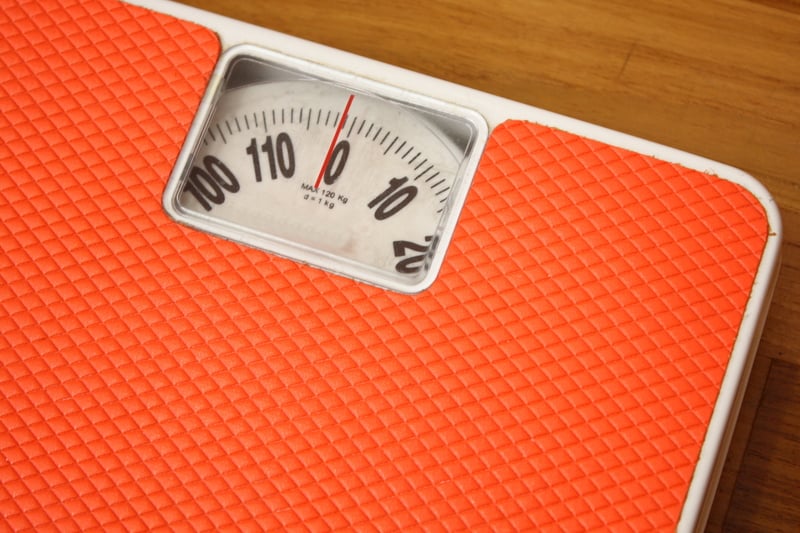
Unintentional and rapid weight loss can be a serious problem and lead to symptoms like muscle loss, loss of energy, and an increased risk of injury and illness. You should visit a doctor regularly to ensure that you are maintaining a healthy weight and aren’t losing weight too quickly as a result of your respiratory condition.
Pulmonary Cachexia
Although weight loss is generally perceived as a good thing for most people, not all weight loss is healthy, even in someone who may be considered overweight. Pulmonary cachexia is one side-effect of COPD that can lead to the unhealthy loss of both muscle and fat tissue. In severe cases, cachexia may result in the loss of a significant amount of muscle function.
Although the exact cause of cachexia is not known, studies have shown that intracellular mechanisms like myonuclear and protein turnover may be the primary cause. In other words, even people who eat enough and get all the proper nutrients through their diet may still experience a loss in body mass index (BMI).

According to Physiology.org, cachexia is a common side-effect of COPD with about 20 to 40 percent of COPD patients affected. Although this condition occurs gradually in most people it’s likely accelerated during acute exacerbations, so it’s important to keep up with the treatment plan your doctor has set for you.
Inflammation
Inflammation in the lungs is the primary cause of COPD and potentially one of the leading causes of weight loss in COPD as well. Both emphysema and bronchitis — the two main types of COPD — result in inflammation in the lungs. Bronchitis is an inflammation of the bronchial tubes which bring air to the alveoli. Emphysema on the other hand, is the result of inflammation on the alveoli, usually due to exposure to irritants like cigarette smoke.
Studies have shown that 85 percent of people experience at least one digestive problem with COPD like bloating which can make it difficult to eat. Although there are a number of things that could potentially be causing this, many COPD patients suffer from hyperinflated lungs due to inflammation and too much air getting trapped in the lungs when breathing. This can put stress on the rib cage, diaphragm, and stomach, especially while eating.
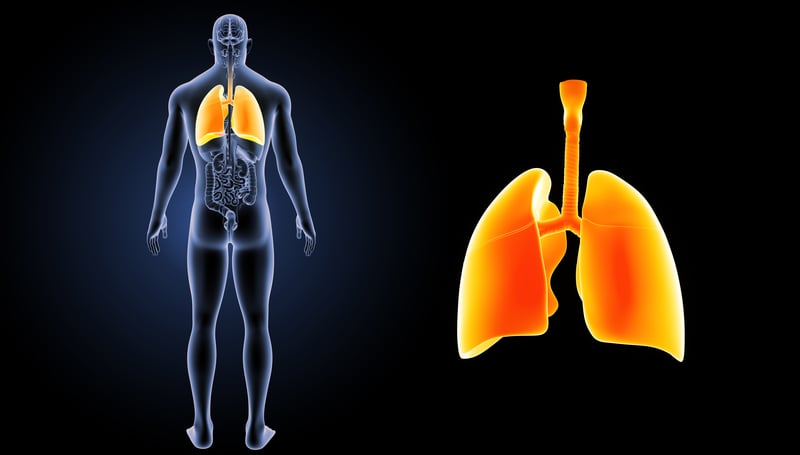
Hormonal Changes
The adrenal glands sit on top of the kidneys and are responsible for a number of important roles in the body. First, and most importantly, they produce hormones that are essential for the normal function of your body. This includes things like regulating your body’s reaction to stress, regulation of blood pressure, and metabolism. There are a number of disorders that can result if the production of hormones is out of balance.
According to COPD News Today, inhaled corticosteroids used to treat COPD and asthma may be at fault for an increased risk of adrenal gland suppression. It’s often difficult to diagnose corticosteroid-induced adrenal suppression because the symptoms can vary widely from something as simple as tiredness to something as serious as a life-threatening illness.
Fortunately, only a small number of people have experienced this issue with inhaled corticosteroids and COPD patients should not quit taking them before speaking with their doctor first.
Anxiety
Anxiety can lead to complications when it comes to weight regulation. One of the primary characteristics of stress and anxiety is an increased release of adrenaline and cortisol in the body. This initiates the “fight or flight” response in your body that can increase your metabolism and cause you to lose weight more quickly. What’s more, anxiety can lead to decreased serotonin and dopamine (the feel good hormone) in the brain. This means you’ll likely feel less enjoyment from eating and you may avoid it as a result.

It’s not uncommon for those coping with COPD to experience anxiety. As symptoms of breathlessness, coughing, and fatigue increase, it’s easy to feel trapped and uncomfortable in your own body. They also may feel stress about being reliant on a loved one for daily tasks or stressed about going somewhere that may cause an exacerbation. For more information on managing anxiety with COPD, read our blog titled COPD and Anxiety: How to Find Peace of Mind.
Weight Gain in COPD Patients
Although it’s significantly less common for someone with a chronic respiratory disease to experience weight gain, it is certainly possible and learning how to keep unnecessary weight off is just as important when it comes to preventing serious COPD exacerbations.
One of the serious threats of being overweight with COPD is the increased risk of obstructive sleep apnea (OSA). According to WebMD, more than half of people with OSA are either overweight or obese. Since sleep apnea causes disruptions in breathing at night, it can be a potentially life-threatening condition for someone who is also suffering with COPD.
Inactivity
Possibly the most common cause of weight gain with COPD is inactivity. As COPD progresses, lung function is reduced significantly. Using a spirometry test, pulmonologists are able to determine both your forced expiratory volume (FEV1) and your forced vital capacity (FVC). Below are the levels of lung function you can expect with each stage of COPD.
- Mild COPD (grade 1) - 80 percent or higher FEV1
- Moderate COPD (grade 2) - 50 to 79 percent FEV1
- Severe COPD (grade 3) - 30 to 49 percent FEV1
- Very severe COPD (grade 4) - Under 30 percent FEV1
It goes without saying that as someone progresses through these stages of COPD, their ability to perform physical tasks will diminish. Many people find that they aren’t able to exercise or perform chores around the house like they used to. Fortunately, pulmonary rehabilitation is an effective method for reducing symptoms of COPD and helping people to regulate their weight more easily while coping with the condition.
Lifestyle Changes
Being diagnosed with COPD means making a lot of lifestyle changes that you may not be prepared to make. Although most people eventually adapt and adjust to a new way of life, some people may find it difficult to cope at first.

It’s easy to fall into bad habits like eating unhealthy food or skipping out on breathing exercises or pulmonary rehabilitation classes. However, these are likely all things that your doctor has recommended as part of your treatment plan and you should take care to follow them as best as possible. You might also be on a strict diet regimen that focuses on providing you with nutrients that you need to improve lung function and reduce COPD symptoms. Although it may seem different at first, stick with it until it becomes routine.
Steroids
Steroids are one of the many medications used to treat acute COPD exacerbations and can be either taken orally or inhaled. These steroids help to fight inflammation in the lungs, reduce swelling, and suppress the immune system so that your body doesn’t attack healthy cells.

Unfortunately, these benefits don’t come without side-effects. Many people who take steroids for COPD experience an increased appetite, fluid retention, and a change in where the body stores fat. This added weight usually appears in the neck, abdomen, and face. And generally, the longer you’re on the steroid and the higher the dose, the more likely you are to experience these symptoms.
Fluid Retention
One thing many people don’t consider when it comes to weight gain is that much of it could be caused by increased fluid retention in their body. Fluid retention is when your body stores water instead of using it. This can be caused by a number of things like pain relievers, antidepressants, and other medications, but one of the most common causes of fluid retention is a high sodium diet and lack of exercise.
Loss of Taste Plays a Role in Weight Management
Aside from the risk factors above, loss of taste or taste dysfunctions can make it difficult to regulate weight and follow a strict dietary routine required for COPD treatment. There are a number of potential causes for this, however, most people tend to experience it more with age, after taking medication, and after smoking. And let’s face it, if you’re not enjoying the food that you’re eating, it’s going to be a lot less likely that you are able to continue eating it.
Medication
Prednisolone is a steroid that can be used to regulate inflammation, metabolism, mineral balance, and the immune system. It’s commonly prescribed by doctors to treat COPD symptoms such as chest tightness, chest pain, and breathlessness. However, some patients report experiencing a metallic taste in their mouth after taking it.

Other drugs like inhaled corticosteroids used to treat asthma and COPD can leave a strange taste in your mouth after using them. Although the taste tends to go away after an hour or two, it can certainly have an impact on your diet, especially if you take medication right before eating.
Age
Taste loss is natural as you age. Over time, taste buds will shrink and be less sensitive to food, especially salty, sweet, or bitter flavors. Since COPD is much more common in old age, it’s imperative that you avoid adding salt or sugar to the food that you eat. Sodium causes your body to retain water, leading to weight gain and increasing your chance of experiencing breathlessness and sleep apnea. Sugar, on the other hand, will also lead to weight gain and leave you feeling fatigued.
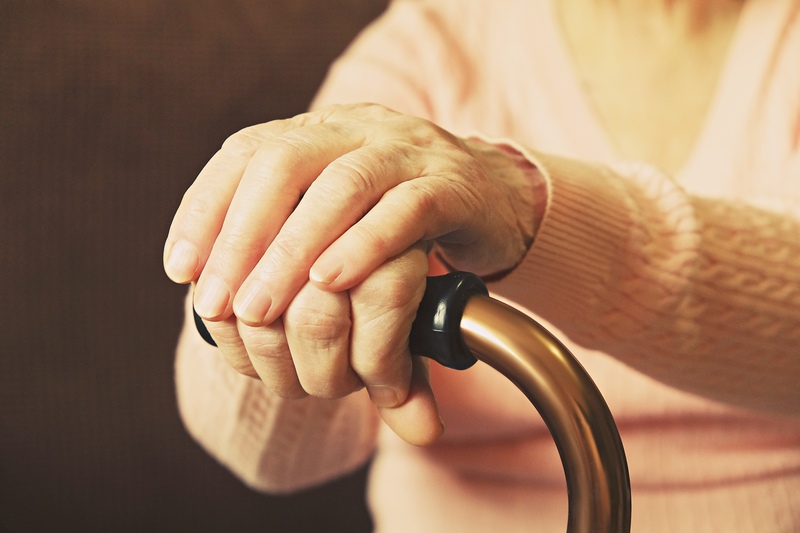
Before adding anything to your diet, you should speak with your doctor who may be able to recommend seasonings that won’t add any additional side effects. Also, be sure to look up recipes for low-sodium meals.
Dry Mouth
Dry mouth is just what it sounds like — dry mouth due to a lack of saliva production. COPD patients often experience dry mouth when undergoing oxygen therapy because the air that’s processed through their machine is not humidified. Having dry mouth frequently can lead to taste loss and difficulty eating.
Fortunately, there are solutions to this problem. Whether you’re using a CPAP machine for sleeping, a home oxygen concentrator, or a portable oxygen concentrator, you can purchase a humidifier that either attaches to the device or you can use a regular home humidifier.
What You Can Do To Manage Your Weight
Weight management doesn’t just help you feel better, it’s crucial for preventing serious COPD exacerbations. If you’re overweight, you’ll be more likely to develop sleep apnea which can result in more exacerbations. On the other hand, if you’re underweight, you may start losing muscle mass rather than fat which makes it more difficult to breathe.
Routine Doctor Visits
The best way to manage your weight with COPD is to ensure that you always visit your doctor routinely. Unfortunately, visiting your doctor once a year is not enough for him/her to be able to notice what is actually causing the weight loss or weight gain, so you’ll need to see them regularly to make sure you’re on the right track.
As we mentioned earlier, maintaining your weight isn’t just about eating right. Your doctor will need to adjust your diet regularly to ensure you’re getting the right nutrients.
Stay Active
It’s normal for someone with COPD to experience declining physical abilities, but in the grand scheme of things, any form of exercise you can manage will help, no matter how insignificant it may seem.

Pulmonary rehabilitation is a type of exercise routine that’s designed specifically for those coping with a chronic respiratory condition. It teaches COPD patients the best way to exercise, what exercises benefit the lungs the most, as well as breathing exercises that will help you feel less fatigued. Not only will pulmonary rehabilitation help you keep off unnecessary weight but it can help you retain your muscle mass.
Reduce Salt Intake
The average American diet is very high in salt which is known to increase blood pressure and cause weight gain, especially through water retention. Although it’s healthy to have some sodium in your diet, it’s best to get it naturally through your food rather than through added salt. Since your sense of taste tends to decline with age, you should try to avoid adding additional salt to every meal and use other seasonings to add flavor instead.
Oxygen Therapy
One of the most effective and common treatment options for COPD is oxygen therapy. And the good news is that keeping up with your oxygen therapy treatment will also help you manage your weight. Like we mentioned before, taking a breath can burn as much as 10 times as many calories for someone with a chronic respiratory disease. However, when you use an oxygen therapy device you won’t be exerting any extra energy to breathe.
If you are on the go frequently and want an oxygen therapy device to match that lifestyle, portable oxygen concentrators will help you achieve that. Since oxygen concentrators draw ambient air, you won’t need to carry a heavy and bulky oxygen tank around with you.
Ask For Help
After being diagnosed with a condition like COPD, there’s always the question of how much independence you should maintain. Independence can be great for self-esteem and to help you lead a more fulfilling life. However, simultaneously, you should never be afraid to ask for help when you need it.

Chances are, you know what it takes to maintain a healthy weight, but if you don’t have the energy to cook like you used to or maintain a healthy lifestyle, you may find it more difficult to manage your weight. A little help from a friend or a loved one can go a long way towards improving your health and you’ll become closer in your relationship as a result.
{{cta('43b79c5e-6bd6-4f02-ac27-2d038d20c146','justifycenter')}}
Conclusion
Maintaining a healthy weight while coping with COPD isn’t all about your diet. There are a number of complications that COPD patients need to deal with in order to avoid unintentional weight loss or weight gain. While a healthy diet should be the foundation of your COPD treatment plan, you should take into consideration all of the above in order to achieve optimal results.
While it’s great to make changes to your routine in order to improve your health, it’s best to consult a doctor or pulmonary specialist first. What may be beneficial for one person could be detrimental for another and having a clear treatment plan to follow is key to your success.
_%20(1).png)
One of the most common questions we hear COPD patients ask is, “how can I clear my airways when they get congested?” As a COPD patient, you’re likely to experience coughing fits that are brought on by the buildup of mucus and sputum in the airways and lungs. And sometimes, no matter how hard you try, you feel like you can’t clear them in order to catch a breath of fresh air. This is far more common than you might expect and it can be a frustrating and sometimes even scary experience.
Another thing that many people don’t realize is that airway clearance can be a lot more complicated than learning how to cough correctly. There are many different techniques that can be applied, and it’s also helpful to know why your airways are becoming congested in the first place. In this post, we’ll help you understand some of these concepts and provide you with a step-by-step guide on how to clear your airways safely.
{{cta('fa8abc2a-1e88-4fa3-82fd-1cb5b9ed43b2','justifycenter')}}
As always, it’s imperative that you speak to your doctor if you experience ongoing issues with coughing, wheezing, or shortness of breath. These symptoms tend to get worse over time unless the root cause is dealt with. What’s more, coughing fits can lead to flare-ups and exacerbations which can put you in the hospital.
Why does COPD Make it Difficult to Clear Your Airways?
There are two different types of chronic lung disease: obstructive and restrictive. A restrictive lung disease like pulmonary fibrosis or interstitial lung disease is one that affects the lungs’ ability to expand. An obstructive lung disease like COPD or bronchiectasis, however, prevents you from fully expelling air from the lungs. This is especially problematic when the patient tries to cough because they may not have the force necessary to clear mucus and other substances from the airways.
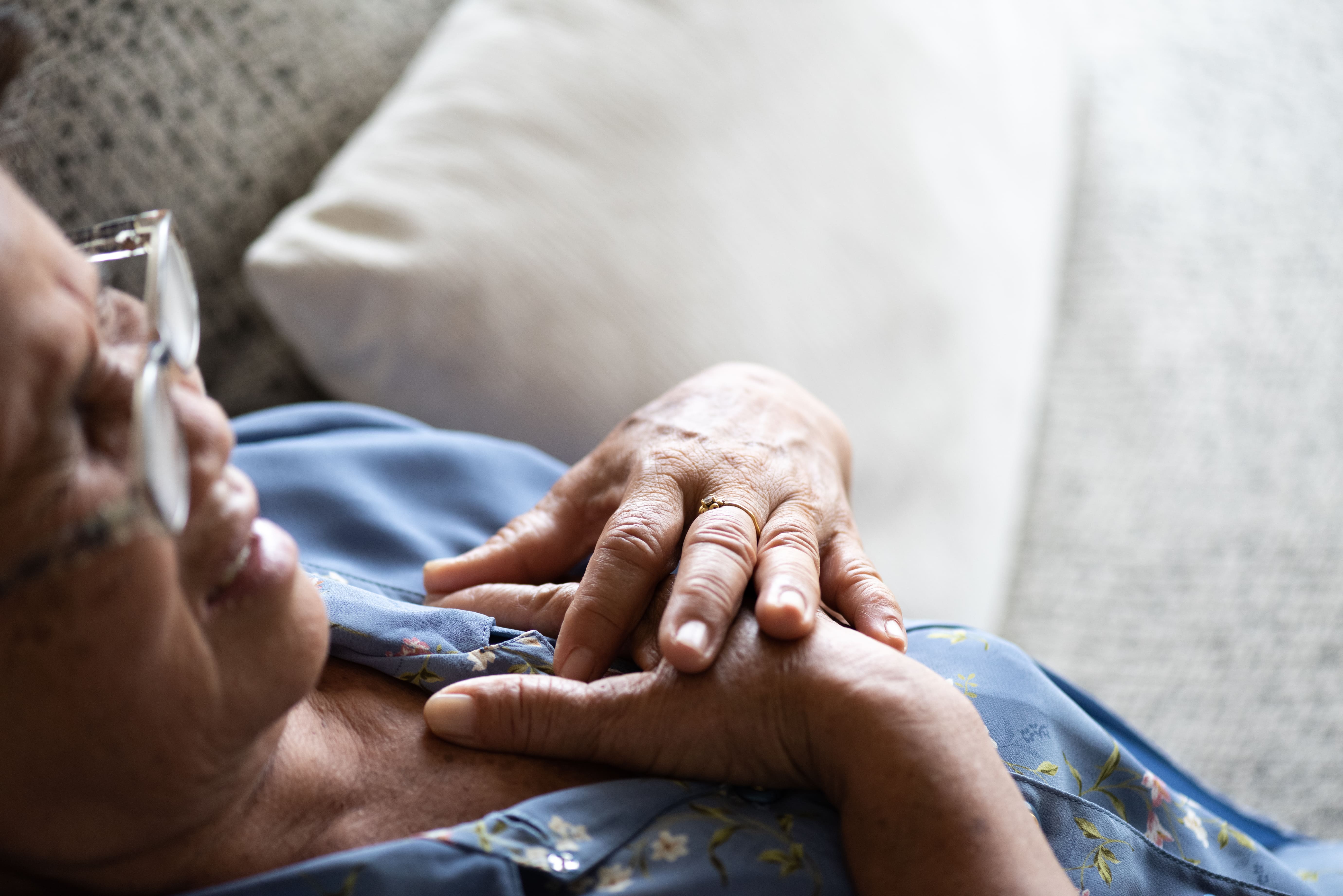
Another reason that COPD makes it more difficult to clear your airways is that this disease is associated with changes in the way that mucus and sputum are produced in the body. In a healthy individual, mucus plays a vital role in the body’s immune function. The body carefully regulates the mucus lining the airways and lungs so that there is enough to trap bacteria but not so much that you choke or can’t breathe naturally. However, in COPD patients, there is usually an overproduction of mucus due to oversized mucus glands and an overabundance of goblet cells.
If you’re a current smoker, this could be another reason that you’re experiencing issues with airway obstruction. According to the Centers for Disease Control and Prevention (CDC), as many as 38 percent of COPD patients are current smokers. This study published in the Karger medical journal found that moderate and heavy smokers have a higher impairment in mucociliary clearance than their non-smoking counterparts. One of the key ways that smoking affects airway clearance is by damaging and killing cilia. These are tiny hair-like organelles that help to push mucus and other debris out of the airways.
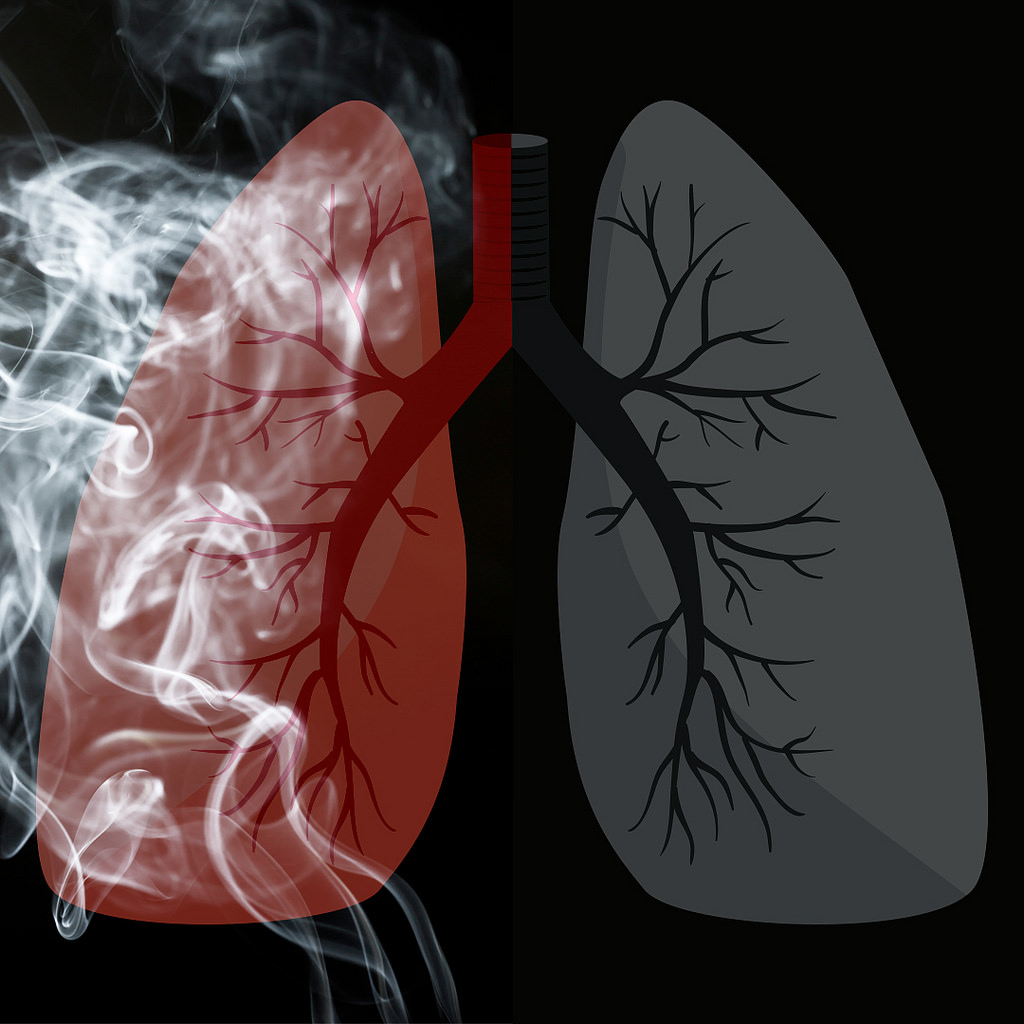
Since there are so many different causes of airway obstruction in COPD, it’s important to have a comprehensive treatment plan to deal with these symptoms. Airway clearance therapy can and should be used, but it won’t be as effective if you aren’t following all other aspects of your treatment plan that your doctor has designed for you. Ideally, if you’re following your treatment plan carefully, you won’t experience mucus buildup as frequently and you’ll only need to use airway clearance techniques in rare circumstances.
What is Airway Clearance Therapy (ACT)
Airway clearance therapy, or sometimes called airway clearance techniques, is a group of scientifically backed methods used for clearing mucus from the airways. These techniques were developed as a more controlled version of our body’s natural airway clearance techniques like coughing and wheezing. A chronic and persistent cough or episodes of wheezing can be extremely unhealthy, especially if they lead to you losing sleep or feeling lightheaded or fatigued. Airway clearance techniques aim to not only make COPD patients more aware of how they’re coughing, but also provide them with some entirely new methods that may be more effective.
-jpg.jpeg)
Generally speaking, airway clearance techniques are divided into seven different categories. Everyone has a slightly different way of practicing these techniques, so don’t be alarmed if your pulmonologist tells you something that differs from what you have read here. Our goal is simply to provide you with an overview so that you can better understand how airway clearance therapy works.
1.) Controlled Coughing
Like we mentioned before, uncontrolled coughing is problematic in COPD patients. Without understanding how your lungs, airways, and mucus work, simply expelling air in an attempt to dislodge any obstruction can be more effort than it’s worth. One of the biggest problems associated with normal coughing or wheezing is that it often causes the airways to collapse, meaning that no matter how hard you cough, the mucus will be stuck. If you hear a wheezing or whistling noise when you cough, this is a sure sign that your airways collapse when you cough. Controlled coughing is focused on keeping the airways open so that you’re not wasting valuable energy and oxygen.
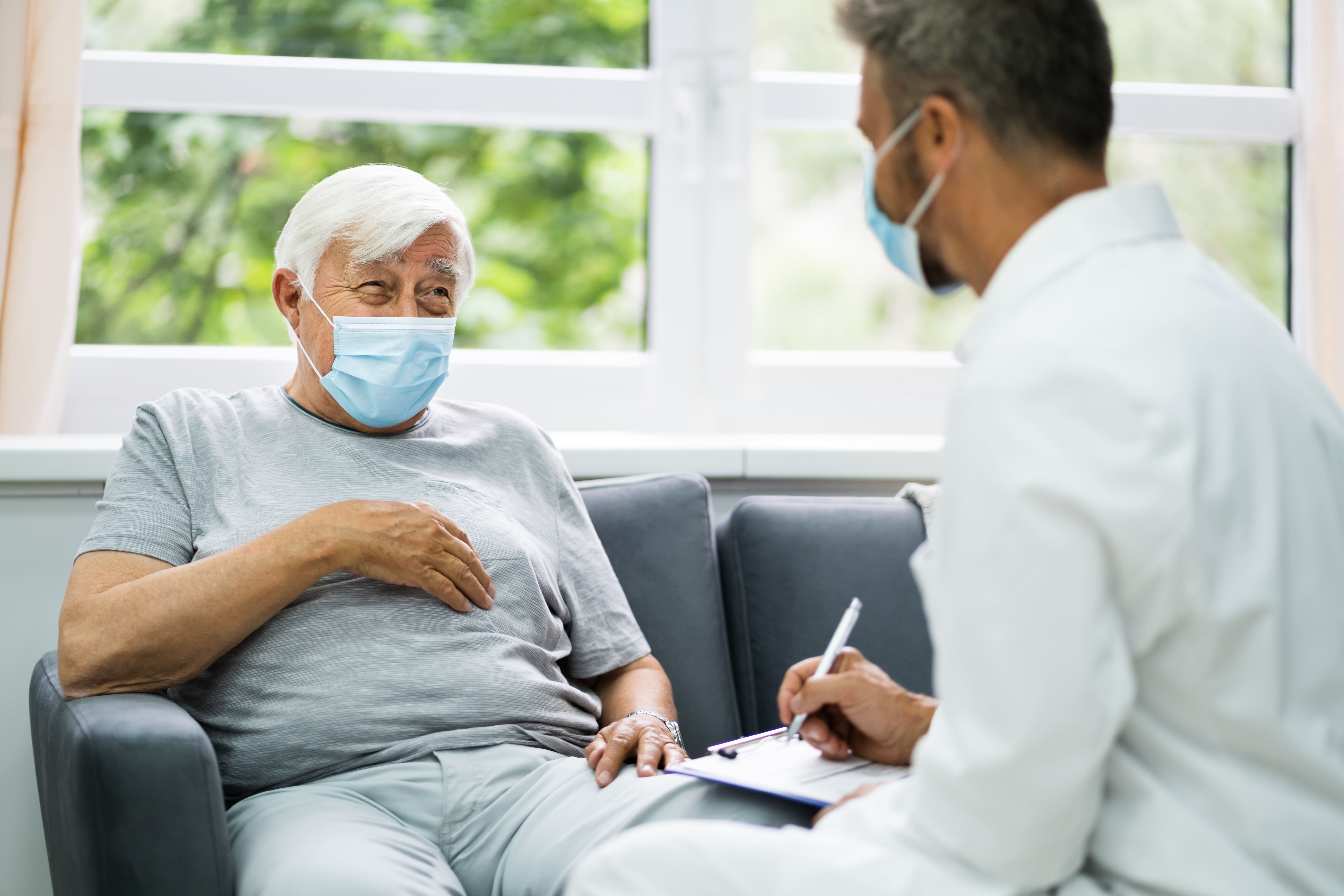
The first rule of controlled coughing is to avoid inhaling sharply through your mouth. This can send mucus back down the airways and be very counterproductive. Instead, inhale slowly but deeply through your nose. This way you have enough oxygen to cough correctly. It’s best to practice controlled coughing while sitting down and you should try to relax as much as possible. Especially try to eliminate the tension in your shoulders and chest because this can contribute to the airways becoming narrow.
Once you’re seated, lean forward slightly and place your hands on your abdomen. You’re going to cough three times and you should really focus on the quality of each one to ensure that the mucus is moving out of your airways rather than back down into your lungs. Be sure to take a deep breath through your nose between each cough to ensure that you move enough air. If you need to take a moment to relax between each cough, this can be helpful.
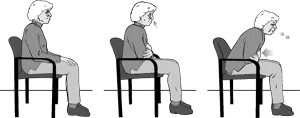
Another technique that’s similar to controlled coughing is huff coughing. For the most part, you will follow the same steps as you would for controlled coughing. However, instead of coughing, you’re going to be forcing air through your airways similar to how you would fog up a mirror or how you would clean a phone screen or your glasses. In other words, you’re expelling air out your mouth without creating any vibrations in your chest or throat.
2.) Autogenic Drainage (AD)
The aim of autogenic drainage is to move mucus from the smaller airways into the larger airways (peripheral airways into central airways). By doing this, it is much easier to dislodge the mucus because it’s all in one area. The rationale for autogenic drainage is based on a principle of solid mechanics called shear force. This is when unaligned forces are applied to an object causing it to bend in two different directions. In the case of autogenic drainage, the mucus and other secretions in the airways are the object that’s being manipulated. This is done through a series of carefully monitored breathing techniques.
3.) Postural Drainage and Percussion (PDP)
Postural drainage and percussion, also known as chest physical therapy (CPT), is a technique that involves using your hands to assist with airway drainage. While you can do PDP on your own, it’s often recommended that you have someone assist you with it, whether it’s a friend, loved one, or your physical therapist. Like autogenic drainage, PDP is a technique that will take some time to perfect so it helps to be patient as you learn the ins and outs of this method.

The reason this method is called “postural” drainage is that you are going to use different positions that leverage gravity in order to drain the mucus from your airways. The general rule of thumb is that your hips should be higher than your chest. Whether this means laying on your back, side, or stomach, you can do whatever is most comfortable for you. Many people prefer to use pillows or blankets to elevate their hips.
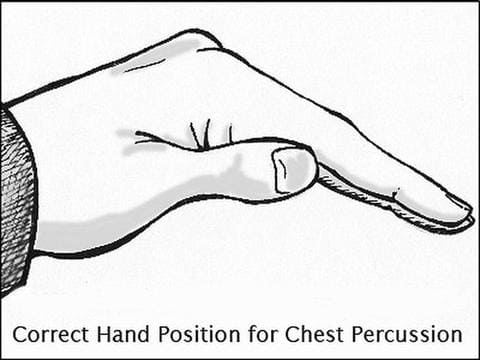
Once you’ve found a comfortable position you can begin the percussion. Most specialists recommend cupping your hand and placing it palm down on your chest. This will allow you to break up the mucus in your chest without hurting yourself. The percussion can also be done on your back but it’s best to have a partner to help you out with this.
4.) Positive Expiratory Pressure (PEP) Therapy
Essentially, the term positive expiratory pressure means experiencing greater resistance when you’re exhaling than when you’re inhaling. This is done with a PEP device which you hold to your mouth and breath into. The device allows you to inhale normally, but when you go to exhale, you experience resistance about four times greater than what you would normally experience. What this does is keeps your airways open as you exhale and allow the force of your air to get behind the mucus and push it out of the airways.
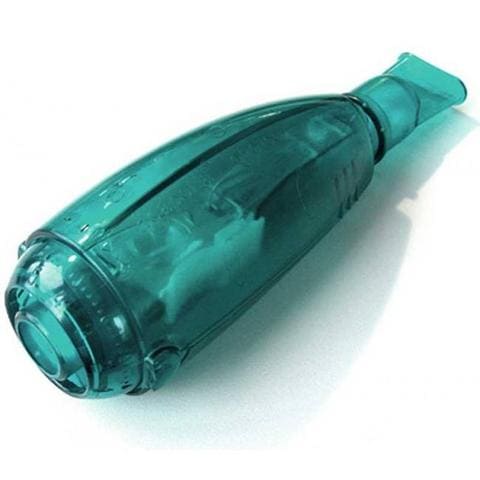
5.) Oscillating Positive Expiratory Pressure
Oscillating positive expiratory pressure therapy is very similar to the method above. However, an oscillating PEP device uses high-frequency oscillations that break up mucus as you exhale. Oscillating PEP devices look similar to traditional PEP devices but they have a ball inside that rattles around as you exhale. This is what creates the vibrations in your upper chest. After blowing into the device several times, you can take a break to clear out any mucus that the device brought up. Then simply repeat the process.
6.) High-Frequency Oscillating Vest
A high-frequency oscillating vest is another tool that can be used for airway clearance. This is an inflatable device that looks a lot like a life vest. The oscillating vest is connected to an air compressor via two hoses. Once it’s turned on, the vest inflates and deflates in rapid succession. The basic principle is that it uses positive and negative pressure changes in the chest to augment peripheral and tracheal mucus movement towards the airway opening. After a set period of time, the device is stopped and the patient can cough to bring up the mucus.

While high-frequency oscillating vests are very effective, they aren’t without disadvantages. These vests can be very expensive to purchase and maintain. What’s more, they’re not very portable in comparison to the PEP devices which we discussed earlier. If you’re someone who travels a lot you might find that high-frequency oscillating vests are more trouble than they’re worth.
7.) Active Cycle of Breathing Technique (ACBT)
The active cycle of breathing technique is an airway clearance method that combines positioning, breathing, and coughing. Since this is the most complex airway clearance technique it’s also the most flexible when it comes to being adapted to fit a variety of patient’s needs. The goals of ACBT include improving the effectiveness of your coughs, improving lung ventilation, and clearing secretions from the lungs. Below are the three different phases of ACBT:
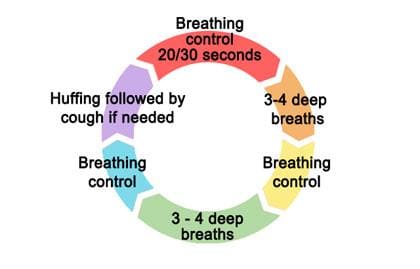
Phase 1 - Breathing Control and Relaxation
The first step in ACBT is to bring your breathing under control and completely relax your body. The majority of the tension in your body will be located in your shoulders, chest, and back, and many people are unaware of how much this can affect the way you breathe. Start by closing your eyes and placing your hands on your stomach. Sit with your back straight and begin to practice pursed lips breathing. This is where you inhale slowly through your nose and exhale fully through pursed lips.
Phase 2 - Thoracic Expansion Exercises
As the title suggests, the aim of phase 2 in the active cycle of breathing technique is to expand the chest. During this step, you will take 3 to 5 deep breaths in through your nose and out through your mouth while keeping your shoulders and chest relaxed. At the peak of each inspiration, you will hold your breath for 2 to 3 seconds. After the allotted time, simply release the air rather than trying to force it out.
Phase 3 - Forced Expiratory Technique (FET)
The forced expiratory technique is another way of saying “huff” cough. Like we described under the “controlled coughing” section, a huff cough is a way of clearing mucus without allowing the airways to collapse. You’re simply pushing air out the lungs but putting more air behind it than you would with a normal breath. You should repeat this after each thoracic expansion that you do.
Other Ways to Prevent Airway Obstruction With COPD
Drink Plenty of Water
Your ability to prevent airway obstruction depends heavily on your level of hydration. Mucus is made up of about 97 percent water. However, slight variations in this can cause it to become extremely thick and difficult to clear from the airways. Since every organ in your body uses water, it’s imperative that you aren’t starving yourself of this vital resource. According to COPD.net, the average COPD patient should drink between 8 and 12 glasses of water every day.

As you work to increase your water intake, it’s also important to reduce your intake of other types of fluid. Milk, and dairy products in general, are known for thickening your mucus so you’re going to want to avoid these as much as possible. Much like salt, sugar has the ability to dehydrate you, so you should avoid sugary sodas, fruit juices, or sweetened tea. If you absolutely have to drink something other than water, try unsweetened hot green tea which will not only thin your mucus but has a number of other health benefits as well.
Maintain a Balanced Diet
Healthy eating is all about getting the right balance of nutrients that your body needs to stay healthy. For COPD patients and people with other respiratory illnesses, this could mean consuming less sodium and salt which contributes to problems like airway obstruction. You should also avoid highly processed foods which can contribute to bloating and thus making it more difficult to breathe. Most COPD patients tend to do better with a diet that is high in protein and healthy fat which is easy to digest and will support healthy lung function.
![]()
Use COPD Medications Effectively
Depending on how severe your COPD is, your doctor has likely prescribed you some medication for coping with your symptoms. One of the most common medications for COPD is called bronchodilators. These medications open up the airways so that you can breathe easier and they can make it easier for you to perform the airway clearance techniques listed above. Ask your doctor about changing up your treatment schedule to assist with airway clearance.

Another medication that can help with airway clearance is a class of drugs called expectorants. These are medications are designed to thin the mucus in your airways making it easier to clear. Expectorants aren’t designed specifically for COPD patients because they’re also used to treat congestion associated with the common cold and the flu. While expectorants are available for over-the-counter purchase, you should be sure to ask your doctor before using them because they may have adverse interactions with the COPD medications you already take.
Pulmonary Rehabilitation
Pulmonary rehabilitation (PR) is an exercise and education program focused on improving lung strength and function. COPD patients should begin pulmonary rehabilitation right after they’re diagnosed so that they learn the best way to take care of their lungs and slow the progression of COPD. Another benefit of PR that many people don’t realize is that it can help with airway clearance. According to a study published in the European Respiratory Journal, exercise improves mucosal clearance in the small airways by releasing moderators that increase fluid secretion and stimulate cilia beat frequency. What’s more, PR increases lung strength and endurance which can help you perform the airway clearance techniques listed above.

Get More Restful Sleep
Getting restful sleep is a problem that many people face for their whole lives. According to the Sleep Association, around 50 to 70 million people suffer from a sleep disorder in the United States. So, as you can imagine, there is a lot of overlap between people suffering from COPD and people suffering from sleep disorders. If you’ve never been diagnosed with a sleep disorder or provided with treatment for your sleep disorder, now is the best time to seek help. Addressing your sleep problems will have undeniable benefits when it comes to helping you manage your COPD. If you’d like to learn more about getting restful sleep with COPD, please read through this article.

Conclusion
Airway clearance therapy is an incredibly important skill for all COPD patients to learn. However, it’s not an all-in-one solution. Drinking enough water, getting enough sleep, eating right, and exercising are all great ways to prevent airway obstruction and prevent the need for alternative therapies. If you’re experiencing frequent coughing or wheezing, we recommend contacting your pulmonologist immediately so that you can address your concerns.
Here at LPT Medical, we specialize in life-saving oxygen equipment which can help you maintain your oxygen levels if you are experiencing a coughing fit or COPD exacerbation. We will help you get the best deal on the market for portable oxygen concentrators like the Caire FreeStyle Comfort or the Inogen One G5. These devices are much lighter and reliable than traditional oxygen delivery devices allowing you to go more places without worrying about whether or not you’re getting enough oxygen. Since the oxygen is administered through a nasal cannula you can still do all of the airway clearance techniques above while you’re receiving oxygen.
{{cta('b59df0c1-c4de-47a8-8e1c-0d33d4b414aa','justifycenter')}}
It’s very important to us that you receive the oxygen concentrator that’s right for you. When you reach out to us, you will be connected with a respiratory specialist who will ask you questions about your oxygen use and lifestyle. If cost is a concern for you, we also have a variety of different buying options including new, used, and refurbished concentrators. We also have financing options available if you’d like to pay in easy monthly installments. Reach out to us either by phone or email for more information.
It is normal for COPD symptoms to change throughout the day in response to your environment, your activities, and even your circadian rhythm. However, many people with COPD, and especially those with severe COPD, notice their symptoms tend to get worse in the morning.
COPD symptoms can be frustrating any time of the day, but they can be particularly burdensome to deal with first thing when you get up. They are more than just a nuisance; morning COPD symptoms can disrupt your morning routine and have a major effect on your quality of life.
Unfortunately, many patients struggle to manage their morning symptoms effectively. That's why, in this post, we're going to tell you everything you need to know about morning COPD symptoms and what you can do to keep them under control.
The following sections will explain why COPD symptoms tend to worsen in the morning, what kinds of symptoms are common, and how they can affect your daily activities and your overall quality of life. Then, we'll discuss a variety of different techniques, including medications, non-pharmacological therapies, and simple habit changes that can help you better manage and minimize your morning symptoms.
{{cta('43b79c5e-6bd6-4f02-ac27-2d038d20c146','justifycenter')}}
The Burden of Morning COPD Symptoms

According to one research survey, a large proportion of people with COPD—about 37 percent—experience worse symptoms in the morning while they're getting ready to start their day. The number was even higher for people with severe COPD, with 46% reporting more severe symptoms during the morning time.
The most common morning symptoms tend to be shortness of breath, persistent coughing, and coughing up phlegm. They tend to begin immediately after waking up, but many patients also report that their symptoms frequently wake them up from sleep.
For many patients, the worst part of morning COPD symptoms is that they make normal activities like showering, dressing, and getting around the house much more difficult to do. They can also make it more difficult to work, to exercise, and to take care of your overall mental and physical health.
Morning symptoms like breathlessness and coughing can also be exhausting to manage, making your chest muscles sore and draining your energy before your day even gets started. They might make you feel sluggish, fatigued, and too sick to go into work or keep up with your usual routine.
These difficulties can be discouraging, and the added stress of anticipating the daily struggle with morning symptoms can be difficult to cope with psychologically. This can trigger significant anxiety and even depressive symptoms that make it difficult to get up, stay active, and face each new day.
Fortunately, morning symptoms are manageable and treatable if you know the proper steps to take. By working with your doctor and examining your daily habits, you can adjust your lifestyle and treatment plan in ways that help keep your morning symptoms in check.
What Causes Morning COPD symptoms

Unfortunately, the research on morning COPD symptoms is limited, and experts aren't exactly sure why COPD tends to get worse in the morning hours specifically. However, there are several studies that highlight this issue and offer some helpful insight into potential causes and solutions.
For example, experts have pinpointed a variety of factors that could trigger more severe COPD symptoms in the morning and early in the day. These include things like smoking, the effects of poor diet and sleep, and the physical exertion required by many morning activities.
Here's a list of some culprits that are likely responsible for triggering morning COPD symptoms:
- Smoking
- Not adhering to your treatment plan
- Nighttime breathing patterns and sleep posture
- Timing of medications like bronchodilators and supplemental oxygen
- Activities like showering and getting ready for the day
For example, it's common to do activities in the morning that require you to walk and be on your feet, such as showering, getting dressed, cleaning house, and working in the garden. In fact, lots of people tend to be more active in the morning than they are during most other parts of the day.
This extra exertion can trigger breathlessness, coughing, and fatigue in people with chronic lung diseases, especially those who suffer from severe COPD. Certain morning activities may also expose you to respiratory irritants, like pollen (from going outdoors), excess humidity (from the shower), and volatile organic compounds (from body, beauty, and cleaning products).
What You Can Do to Manage and Minimize Your Morning COPD Symptoms
Use Proper Coughing & Mucus Clearance Techniques

A very common symptom of COPD is excess mucus in the airways, which often causes a chronic cough. This kind of cough is triggered by the need to bring mucus up and out of your lungs, which helps clear out your airways so you can breathe.
The phlegm that you cough up is known as sputum, which consists of mucus from your lungs and airways mixed with saliva from your mouth. A large percentage of people with COPD experience a chronic cough with sputum that tends to be the worst in the morning.
Luckily, there are several different exercises, known as mucus clearance techniques (or airway clearance techniques), that you can use to reduce the amount of mucus that builds up in your airways. These include techniques you can do on your own like controlled coughing, methods that require another person to help (e.g. chest percussion), and techniques that require special tools (e.g. lung flute)
Here's a list of some of the most common and effective mucus clearance techniques for COPD:
- Huff coughing
- Deep coughing
- Postural drainage
- Chest percussion
- Using a lung flute (a special medical instrument that produces vibrations to loosen mucus)
- Using a high frequency chest wall oscillation (a special vest that vibrates your chest)
The purpose of all of these techniques is to loosen up the mucus sticking to walls of your lungs and airways so you can get it out by coughing. This helps clear some of the obstruction from your airways, making it easier to breathe and reducing your need to cough as you go about your day.

You might find that mucus clearance techniques help your morning cough most when you use them right before bed or shortly after getting up in the morning. Either way you decide to do it, mucus clearance techniques are an important part of COPD treatment that can reduce your risk for lung infections and exacerbations in addition to treating your chronic cough.
To learn more about the different types of mucus clearance techniques and how to do them, check out this comprehensive guide. It includes step-by-step guides for a several different techniques, as well as a variety of other tips and tricks for reducing mucus in your airways.
Practice Breathing Techniques in the Morning

If you tend to suffer from shortness of breath early in the day, then practicing breathing exercises in the morning might be able to help. There are several different kinds of breathing techniques you can use, all of them simple and easy to do.
Pursed-lips breathing, for instance, is a technique that allows you to breathe better and more easily push all the air out your lungs when you exhale. This is especially helpful for getting rid of trapped air in the lungs, which worsens shortness of breath and is especially common in people with emphysema.
Another breathing technique is diaphragmatic breathing, a technique that encourages you to use your diaphragm, instead of your chest muscles, to breathe. This reduces strain on your chest and breathing muscles, making it easier and more comfortable to breathe.
Studies show that breathing techniques can reduce shortness of breath both during exercise and at rest. They can also help you learn how to control your breathing better in situations that tend to make you feel short of breath.
The great thing about breathing techniques is that they are so simple to remember and you can do them anytime and anywhere you need. You can even start practicing breathing exercises before getting out of bed!
By paying more attention to your breathing and putting exercises you've learned to use, you can prevent or reduce the amount of breathlessness you experience as you go about morning activities that tend to trigger shortness of breath. Pursed-lips breathing, for instance, can help you keep your breathing steady and under control when you shower, get dressed, and do other tasks around the house.
If you want to learn how to perform these and other breathing techniques, check out our guide to COPD breathing exercises here. This article includes several step-by-step guides to help you practice breathing exercises at home as well as a variety of practical tips for how to use these techniques more effectively.
Talk to Your Doctor about Adjusting Your Medication

If you notice that your COPD symptoms tend to get worse in the morning, it's important to tell your doctor. The more your doctor knows about your symptoms and when they they flare up, the better he can tailor your treatment to manage your symptoms throughout the day.
For example, your doctor might suggest that you use a quick-acting bronchodilator medication first thing in the morning after you get up. He might also have you try a new medication (e.g. a twice-daily maintenance inhaler instead of a once-a-day medication) or instruct you to take your medications at a different time of day so that they are more effective in the morning.
{{cta('b59df0c1-c4de-47a8-8e1c-0d33d4b414aa','justifycenter')}}
Your doctor can also prescribe new medications or adjust your medication dosage so your symptoms are better controlled. He can also tell you whether or not you could benefit from over-the-counter medications to target specific morning symptoms; over-the-counter expectorants, for instance, loosens up mucus to facilitate airway clearance and potentially reduce a morning cough.
Of course, you should never change your medication dosage or schedule without your doctor's explicit permission. You should always follow your treatment plan exactly as written, and all adjustments must be approved and supervised by your doctor.
However, before you even consider talking to your doctor about changing your treatment plan, you first need to make sure that you're currently taking your medications as prescribed. If you aren't following your COPD treatment plan and using your medications exactly as instructed, then that's the first thing you need to change.
Unfortunately, studies show that a large number of people with COPD don't take their medications consistently or correctly, and this is a major cause of morning COPD symptoms. Other studies show that more than two-thirds of people with COPD do not use their inhalers correctly.

This is extremely important, because taking your medication exactly as directed and carefully following the instructions for your inhaler is necessary to keep your COPD symptoms under control. Poor inhaler technique alone can have a huge impact on your health by preventing you from getting a full dose of medication.
Because of this, you should regularly review your COPD action plan and your medication instructions until you're positive you fully understand your own treatment. Also, you should never hesitate to ask your doctor to explain anything related to your health and your treatment, including how to use your inhaler and how to follow your COPD action plan.
Get Better Sleep
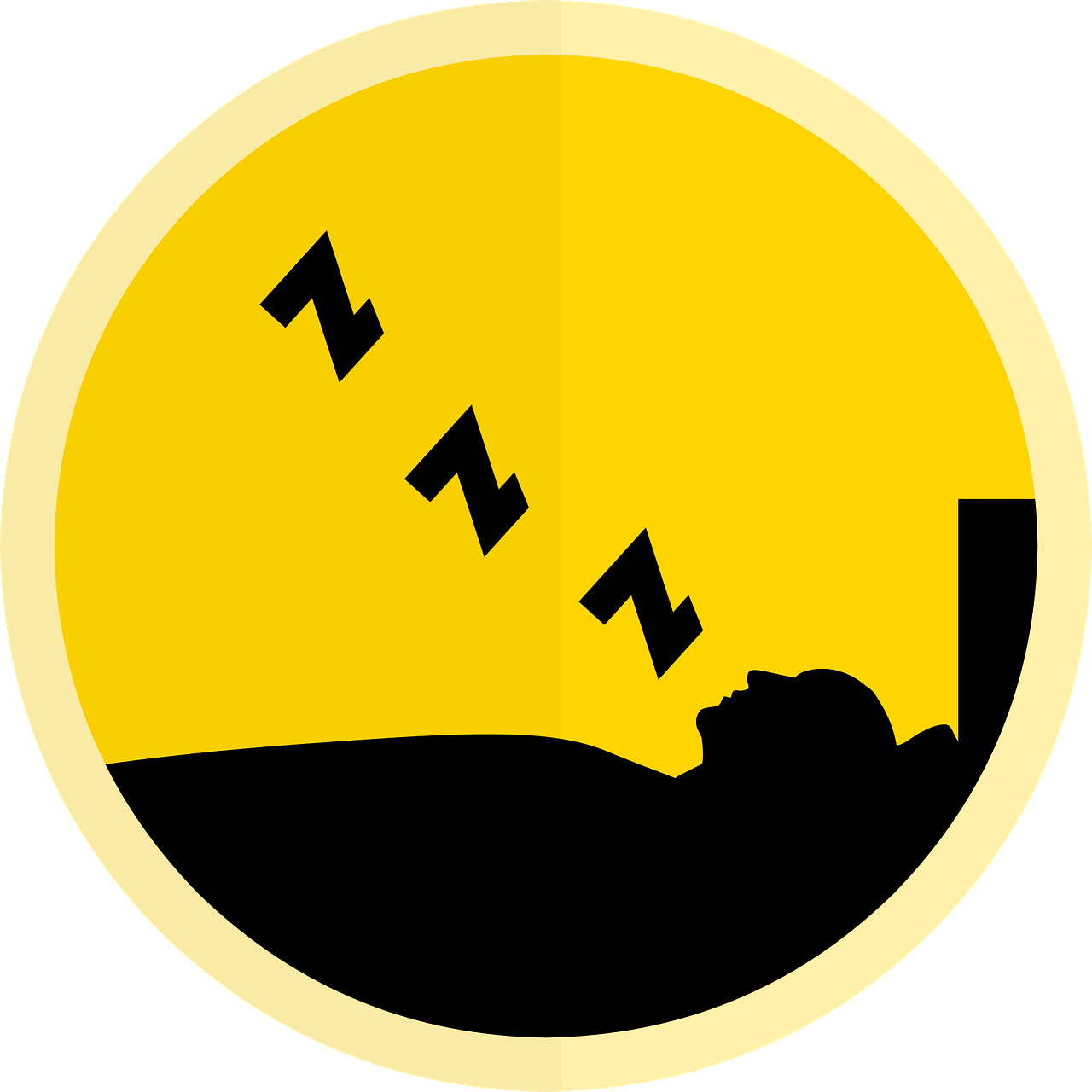
How well you sleep during the night can have a major impact on how well you feel in the morning when you get up. It can also have a major impact on your COPD symptoms and your overall health.
Unfortunately, about forty percent of people with COPD struggle to get good-quality sleep during the night. This can be caused by a variety of factors, including worsened nighttime symptoms, sleep disorders, and normal biological changes that happen in your body while you sleep.
For instance, your respiration rate declines when you fall asleep, causing you to breathe more slowly and shallowly than you do when you're awake. This can worsen COPD symptoms like shortness of breath at night, making it more difficult to fall and stay asleep.
Some COPD patients also experience nighttime oxygen desaturation, or hypoxemia, which happens when your lungs are unable to absorb an adequate amount of oxygen to meet your body's needs. This can cause you to wake frequently during the night and lead to a variety of other symptoms, including morning fatigue and cognitive impairment.
Research shows that poor nighttime sleep quality is linked to a variety of morning symptoms that many people with COPD experience on a regular basis. This includes symptoms like breathlessness, more frequent exacerbations, and more difficulty getting out of bed in the morning.

Poor sleep alone can also cause mild cognitive impairment, which is a common in people with COPD. This causes problems like memory loss and concentration difficulties that can affect your morning routine; for instance, it could make it more difficult to remember things like taking your medications or other important tasks you need to finish to get ready for the day.
So, now that you understand how sleep quality can impact your morning symptoms, what can you do in order to actually get better sleep? Unfortunately, the answer isn't always simple, and you may need to work with your doctor or a sleep specialist in order to find solutions that work for you.
For example, if you experience nighttime oxygen desaturation, your doctor might prescribe supplemental oxygen for you to use specifically at night while you sleep. This will help keep your blood oxygen levels up at night, which can reduce fatigue, cognitive impairment, and other symptoms of oxygen deprivation that you experience in the morning.
Sleep posture is also important, as some sleeping positions make it easier or more difficult to breathe. Most experts suggest that people with COPD sleep on their side for better breathing, since sleeping on your back or stomach can put extra weight and pressure on your chest.
There are also a variety of practical changes you can make to your bedroom and bedtime routine that make it easier to sleep comfortably and get quality rest at night. A good place to start is establishing a consistent nighttime routine, which is a simple yet proven method for improving your sleep.
You should also try to create a bedroom environment that is quiet, relaxing, and free from stressors and distractions. It helps to treat your bed like a sacred place meant only for sleep and sex, and avoid using electronics or doing anything else besides resting when you are in your bed.
If you wake frequently during the night or feel tired in the morning despite getting adequate sleep, you might also need to get tested for a sleep disorder like obstructive sleep apnea. Sleep apnea is a very common disorder that affects a large number of people with COPD, and getting diagnosed and treated for it can drastically improve your sleep.
Treat Yourself to Proper Nutrition

If you find it difficult to muster up the energy in the morning that you need to face the day, then improving your diet might help. Unfortunately, many people with COPD struggle with activities like shopping, cooking, and even eating because they make it more difficult to breathe.
However, these activities are all necessary parts of eating a healthy diet, which is particularly vital for people with COPD. Eating whole, nutritious foods ensures that your body has the energy it needs to stay active, and that your lungs have the fuel they need to function efficiently.
While it may not have a direct effect on morning COPD symptoms like breathlessness and coughing, a healthy diet can boost your energy levels and make it easier to manage your morning routine. When your body is properly nourished, you may find it easier to get out of bed in the morning and stay active throughout the day.
A nutritious diet can also help combat fatigue, a common COPD symptom that can reduce your ability to work, exercise, and function well in the morning. It can also help prevent lung infections and a variety of other COPD- and age-related health conditions like heart disease and osteoporosis.
If you have trouble eating enough nutritious foods or need help understanding what a healthy diet looks like, you can always ask your doctor or a dietitian for help. They can help point you in the right direction and even help you put together a personalized nutrition plan.
We've also created a number of healthy diet and nutrition guides specifically for people with COPD. You can use these resources to learn more about what a COPD-healthy diet looks like, how to recognize healthy versus unhealthy foods, and even how different foods can affect your COPD symptoms.
These guides also include a plethora of practical tips that can help you smoothly integrate healthier diet and eating habits into your daily life. They will show you how to make shopping for, cooking with, and eating nutritious foods more manageable, even if you suffer from severe COPD.
Check out the following guides for more information:
- Healthy foods you should eat if you have COPD
- Unhealthy foods you should avoid if you have COPD
- Tips for simplifying and streamlining your shopping, cooking, and meal planning
- How a carb-heavy diet can make it harder to breathe
Streamline Your Morning Routine

Nearly three-quarters of people with severe COPD experience morning symptoms that are bad enough to interfere with their morning routines. If you are one of those people, try not to get discouraged; there are a variety of things you can do to streamline your morning routine and make it easier to manage.
You can start by looking for ways to reduce the amount of physical activity you have to do in the morning. If you can minimize the amount of walking, reaching, and bending you have to do, you can reduce the amount of breathlessness you experience as you go about your morning routine.
For example, you can intentionally organize your home in such a way that the items you use every morning are in the most logical, convenient, and easy-to-reach places. This includes things like clothing, towels, toiletries, and cooking supplies that you need to access every day.
Showers are another major source of breathlessness and fatigue in the mornings; this is due to both the physical exertion required to shower and the humidity it releases into the air. However, you can reduce your symptoms both during and after showering by using shower aids (like shower chairs and handles) and by taking care to vent humidity from the bathroom via a window or vent.
You might also be able to reduce the strain that morning activities put on your lungs by reducing your total morning workload. For example, you could move some of the tasks you normally do in the morning to a different time of day when your symptoms are likely to be less severe, or you could ask friends or family members to help you with the most exhausting tasks.
Which methods work for you will depend on your home's layout, your individual lifestyle, and the severity of your disease. Whatever you choose, it's important when you have COPD to make adjustments to your daily habits and routines as needed so that you can live and work as comfortably as possible.
Eliminate Respiratory Irritants from Your Morning Routine



 So we can find the best portable oxygen concentrator for your needs!
So we can find the best portable oxygen concentrator for your needs!













